#Panzer general allied assault
Explore tagged Tumblr posts
Text

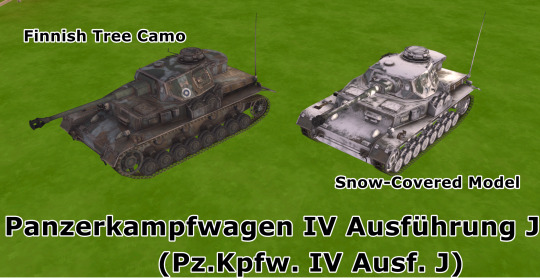

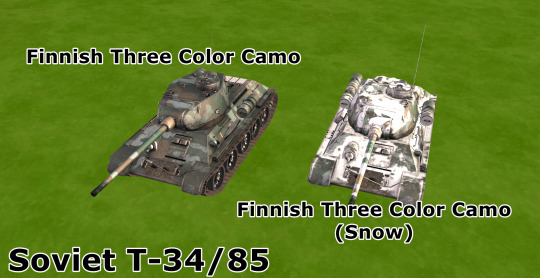

Finnish Army WW2 Medium Tanks
Another Sequel of Of Great Projects about Weapons and Heavy Machinery That Used During Winter War (1939-1940) & Continuation War (1941-1944). This Time Around Covering Medium Tanks that used by Finn. Like A Previous Project Finnish Army During WW2 Relied Captured Soviets Tanks, Obsolete WW1 Products Or Licensed Products From Allied Countries Like Germany Disclaimer:Due Heavy Censorship Regarding Swastika Usage in Western Society, The Details of The Tanks Are Replaced With Roundel Instead of Finnish Hakaristi. Here We go
LINK
Panzerkampfwagen IV Ausführung J The Panzerkampfwagen IV Ausführung J, also known as Gerät 550 or Sonderkraftfahrzeug 161/2, was the last variant of the famed Panzer IV. It was produced from January 1944 to the last days of April 1945 in the Nibelungenwerk (Ni-Werk) factory in Sankt Valentin, northern Austria.
This variant was characterized by many modifications made to the previous models in order to speed up production and save on valuable raw materials.
Sturmgeschütz III Ausführung G The Sturmgeschütz III (StuG III) assault gun was Germany's most-produced fully tracked armoured fighting vehicle during World War II, and second-most produced German armored combat vehicle of any type after the Sd.Kfz. 251 half-track. It was built on a slightly modified Panzer III chassis, replacing the turret with an armored, fixed superstructure mounting a more powerful gun. Initially intended as a mobile assault gun for direct-fire support for infantry, the StuG III was continually modified, and much like the later Jagdpanzer vehicles, was employed as a tank destroyer.
This particular model. the G variant of the StuG III tank destroyer comes with thicker armour of up to 80 mm on the front glacis and a 75 mm StuK 40 L/48 gun that gives the vehicle characteristics on par with a Panzer IV. With this cannon on a low-profile construction due to its casemate design, the StuG III G can prove to be a formidable vehicle in the ambush role.
Soviet T-34/85
The T-34 is a Soviet medium tank from World War II. When introduced, its 76.2 mm (3 in) tank gun was more powerful than its contemporaries,[8] and its 60-degree sloped armour provided good protection against anti-tank weapons. The T-34 had a profound effect on the conflict on the Eastern Front, and had a long-lasting impact on tank design. The tank was praised by multiple German generals when encountered during Operation Barbarossa, although its armour and armament were surpassed later in the war.
Replacing many light and medium tanks in Red Army service, it was the most-produced tank of the war, as well as the second most-produced tank of all time (after its successor, the T-54/T-55 series). With 44,900 lost during the war, it also suffered the most tank losses ever. Its development led directly to the T-44, then the T-54 and T-55 series of tanks, which in turn evolved into the later T-62, that form the armoured core of many modern armies. T-34 variants were widely exported after World War II, and as recently as 2010 more than 130 were still in service.
This Particular Model: The T-34-85 (German designation: T-34/85) was a major improvement with an 85 mm gun in a three-man turret.
Soviet T-28 Model 1938
The T-28 was a Soviet multi-turreted medium tank. The prototype was completed in 1931, and production began in late 1932. It was an infantry support tank intended to break through fortified defences. The T-28 was designed to complement the heavier T-35 (also multi-turreted), with which it shared turret designs. The type did not have great success in combat, but it played an important role as a development project for Soviet tank designers. A series of new ideas and solutions that were tried out on the T-28 were later incorporated in future models.
This Particular Model is T-28 Model 1938 (T-28B) – version with the improved L-10 76.2 mm gun (from 16.5 to 26 calibres). Some older tanks were also backfitted with spare L-10 guns. The rod antenna replaced the horseshoe in early 1939.
#the sims 4#the sims#the sims 4 custom content#ts4 cc#ts4military#the sims 4 military#ts4#the sim#the sims 4 cc#ts4cc#winter war#finnish#suomi#soviet union#the sims 4 decades challenge#sims 4 decades#ts4 decades challenge#1940s#1930s vintage#1930s#the sims 4 ww2#sims 4 war#finland
26 notes
·
View notes
Text
THIS IS COMPLETELY IGNORING THE TIME THE ALLIES DID IT TOO. AND IT WORKED.
Operation Bertram was a meticulously planned operation that hinged on a northern assault, where the objective was to draw Axis Panzers into a counter-attack. The Allies had decided to, not only put some of their men in the south, but also create a massive work of deception.
Fake painted tanks made of plywood, fake trucks out of plywood on a half of a tank,

even a fake water pipeline made from fucking TIN CANS, everything, all to make it look like the fakes would attack in the coming weeks.
After the (inevitable) win, it was revealed that even the Nazi generals at the battle were confused, with one overestimated Allied power, and the other miscalculating when they would actually attack.
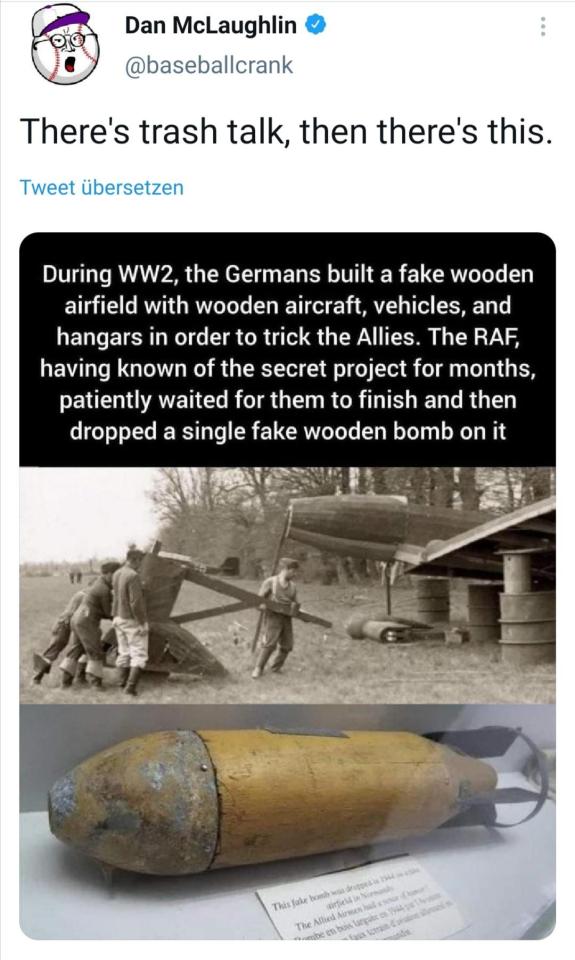
82K notes
·
View notes
Text

• Solothrun S 18-1000 Anti Tank Rifle
The Solothurn S 18-1000 was a Swiss-built 20 mm Anti-Tank rifle which was an upgraded version of the earlier S 18-100. It saw service in both the Axis and Allied forces and was deployed in many theatres through the war.
The Solothurn firearms company was owned by the German firm Rheinmetall, who used the Swiss company to manufacture arms which were prohibited for manufacture by any German firm under arms limitations imposed at the end of the First World War. To bypass these restrictions, Rheinmetall set up a subsidiary in Switzerland in 1929, Waffenfabrik Solothurn. This meant that German engineers could design, test and build weapons without the worry of the victorious Allied powers faulting on Germany for not holding to the Versailles Treaty. In 1930, they had developed the 20×138mmB cartridge or ‘Short Solothurn’, which was one of the most powerful 20 mm rounds in existence at the time and remained in use until the early 1950s. In 1933, development started on a more practical anti-tank weapon, the S 18-100. This 44 kg, bull-pup, hard-hitting gun was placed on the export market in 1934 and was soon picked up by Italy, Hungary, and the Netherlands to name but a few. It was decided in the late 1930s that the S 18-100 series needed a more substantial upgrade (previously the S18-100 saw minor improvements in the S 18-150, S 18-154 and S 18-500). Using the improved 20×138mmB cartridge, also known as the ‘Long Solothurn’, and adding a longer barrel, a ‘harmonica’ style muzzle break, improved action and some other minor modifications, a newer, more hard-hitting version of the Solothurn was created.
The weapon worked on a short recoil system, meaning that the barrel moved slightly backward when fired. Because of the large recoil spring, it required a ratchet crank in order to pull the bolt back to set it up for operations. Once the bolt was pulled back, a magazine could then be loaded. When fired, the barrel recoiled, moving the attached rotary bolt and unlocking the bolt which then ejected the spent casing. The bolt is then driven forward by the large spring, loading a fresh cartridge from the magazine. Like many anti-tank rifles of the time, it came with an integrated bipod, which allowed for some recoil absorption, and a single adjustable monopod to the rear next to a cushioned butt plate to ensure the recoil would be minimized on the shooter. These modifications increased the weight from a substantial 45 kg (99lbs) to a hefty 53 kg (116 lbs) and saw Solothurn develop the SO9 carriage for it. This was a simple two-wheeled carriage which had space for two ammunition boxes and allowed for free traverse. During Solothurn’s trials in 1939, it performed quite respectfully. The much improved ‘Long Solothurn’ round coupled with the 144.78mm (57 inch) long barrel gave it a muzzle velocity of 910 m/s and could penetrate 35 mm of armor plate at 300 meters.
After trials, Solothurn approved the S 18-1000 for production. The design of the weapon, alongside its impressive trail performance, saw it gain attraction on the international market. The first nation to acquire the S 18-1000 for service was the Swiss Army, which placed an initial order for 60. These were designated Tankbüchse Solo 40 and were delivered in the first quarter of 1940. The Netherlands had bought six S 18-15 in 1937 for trials but rejected them upon seeing the initial results for the S18-1000. A definitive order for 662 S18-1000s was placed in late 1938, divided as 340 for the Royal Netherlands Army and 322 for the Royal Netherlands East Indies Army (KNIL). By the time of the German invasion in May 1940, 125 Dutch Army and 72 KNIL rifles had been delivered. The Italians also looked at the S 18-1000 after rejecting the S 18-100 in 1934. They placed initial orders in 1939 for trials and the first pieces arrived in early 1940 being designated Carabina “S”. At the conclusion of the trials, the Italian Royal Army wanted to equip every infantry battalion with 6 pieces. It is unknown how many were delivered to the Italians, but it is thought to be around 578. Hungary had purchased the S 18-100 in 1935 and were producing their own licensed variant, the 36M 20mm Nehézpuska. After the Slovak–Hungarian War, they realized that the 36M was in need of upgrading and purchased around 50 of the new S 18-1000 in early 1940. Finland was attempting to modernize its military inventory in the run-up to the Winter War of November 1939. As part of this, one S 18-1000 was purchased by the Puolustusministeri�� (Ministry of Defence) in August 1939. Unfortunately, though, any chance of purchasing more was rendered difficult due to the Soviet-German Molotov-Ribbentrop Pact which saw Germany restrict arms shipments to Finland through its territory.
When the German military crossed the Polish border on the morning of September 1st,1939, the nations of Europe realized that another war was unavoidable. The armies mobilized against the threats and so the Solothurn S 18-1000 was to be put to the test. After Poland fell to the joint German-Soviet invasion, Germany focused it's attention to the Anglo-French alliance, but outside a few skirmishes on the border nothing occurred for eight months in what became known as the "Phoney War". The S 18-1000's baptism of fire occurred during the German invasion of the Netherlands. The Germans launched their offensive against the Western allies on the morning of May 10th,1940. The 4th Panzer Division was given orders to secure the strategically important Dutch city of Maastricht. The city contained vital bridges over the Maas River, as well as sat to the north of the Belgian Fort Eben-Emael. The Dutch had been on alert since May 7th and troops had been deployed to areas the General Staff felt were vital to the German line of attack. Sergeant Van der Sande was in command of an anti-tank rifle section containing two S 18-1000s and was ordered to deploy his weapons near the two bridges of Wilhelminabrug and Sint Servaasbrug and delay any German advance. At 05:15 on the morning of the May 10th, the first German vehicles were spotted by der Sande’s section and the two anti-tank gunners, prepared their weapons. The order to fire was given and two armored cars were out of action and a third was severely crippled. The Germans reacted by bringing up a 37 mm anti-tank gun and firing at the defensive position forcing the surviving Dutchmen to retreat across the river. The action helped delay the German vanguard enough that the two bridges were blown at 06:00.
A kilometer north of the Wilhelminabrug Bridge was the railway bridge and another strategic objective for the Germans. A platoon of 35 Dutch soldiers, with a pair of Solothurns, held their position against a mainly infantry assault. Soon the platoon was ordered to withdrawal across the bridge and within moments the bridge was blown. However, the action did not stop there. The German infantry force soon received reinforcements and attempted to secure the bridge in order to effect repairs. Two armored cars attempted to cross the river but were destroyed by the Solothurns. A Panzer I was also disabled as it went to the edge of the riverbank. The fighting became intense and more armor was brought forward, including a handful of Panzerjäger I tank destroyers, two were subsequently knocked out by the anti-tank rifles and soon the Dutch found themselves overwhelmed. Despite the Dutch loosing the battle, their bravery and the hard-hitting power of the Solothurns accounted for several destroyed German AFVs. The German Army is known to have acquired a number of Solothurn S-18 rifles, including the 1000 model, and deployed them alongside their own anti-tank rifles. What is not know is exactly how many or their exact deployment.
The next known usages of the Solothurn S 18-1000 was by the Italians in the Desert Campaign. Italy received its first batch of 100 Solothurn S 18-1000s in late 1940 and immediately shipped them to their troops serving in the African desert. The S 18-1000s were given to elite units like the Bersaglieri (an Italian light infantry unit) and Compagnie Auto-Avio-Sahariane (Auto-Saharan Companies, long range desert units). More Solothurns started to arrive at the end of 1941/early 1942 and were assigned on the basis of 9 per Bersaglieri to fit in with their intended role as light infantry. The hard-hitting power, coupled with their small silhouette, meant that the weapon could be effectively used against the Commonwealth forces and their lightly armored tanks. When the Camionetta Desertica SPA-Viberti AS.42 arrived in September 1942, several were equipped with the S 18-1000 to help in the company’s mission of hunting down the British LRDG. In this role, the S 18-1000 succeeded, as the LRDG operated in similarly open-topped and lightly armored four-wheel vehicles. Another Italian use of the S 18-1000 that is often forgotten is the L3 cc (controcarro or anti-tank). Using the Carro Veloce L3/35 light tank as a base, the twin 8mm Bredas were replaced with the Solothurn. An exact number of how many were produced is not known, but it was not many and they arrived in Libya in late 1942. They performed adequately in the Axis retreat through Africa and some participated in the famous Battle of Kasserine Pass.
As the weapon was deployed to Italian frontline units in Africa, it was inevitable that some would fall into the hands of the Commonwealth forces they were fighting against. The Australian 2/2nd Anti-Tank Regiment had one of its reserve batteries equipped with a number of captured Solothurns during the Syria–Lebanon Campaign. How widespread it was among other Commonwealth units is not known, but it can be speculated that several Solothurns would have been repurposed. As the war progressed and AFV's armor was increased, it seemed that the Solothurn was losing its place on the battlefield. As the war raged on the Solothurn was seen less and less and it is believed that the last combat uses of the S 18-1000 were by Italian forces of the National Republican Army as they fought frantically against the Allied advance. A select fire version was produced in 1942, designated the S 18-1100 Universalwaffe (universal weapon) and was sold with a specialized AA mount to be able to engage aircraft, as well as the SO 9 carriage for use against AFVs. Not many, a few hundred, of these were produced until production was stopped at the end of 1942/early 1943. After the war, hundreds of S 18-1000s were put into the lucrative US gun market where they were sold off to gun collectors and enthusiasts. Today it is a rare find but there is still a number of them in the hands of collectors and occasionally they may be found upon the firing ranges.
#second world war#world war 2#world war ii#military history#wwii#history#german history#hungarian history#military equipment#tank warfare#firearms
155 notes
·
View notes
Text
SnK Episode 66 Poll Results (for Anime Only Watchers)

The poll closed with 102 responses. Thank you to everyone who participated!
Please note that these are the results for the Anime Only Watchers’ poll. If you wish to see the results for the Manga Readers’ poll, click here.
Anime only watchers, beware of spoilers if you venture over to the manga readers’ poll results.
--
RATE THE EPISODE 96 Responses

“Assault” got fantastic reviews from anime watchers, with the majority (93.8%) ranked the episode a 4 or a 5. No one seemed to have negative feelings about the episode this week.
can't wait for the next
epic
amazing
BEST
WHICH OF THE FOLLOWING ACTION MOMENTS WAS YOUR FAVORITE? 96 Responses
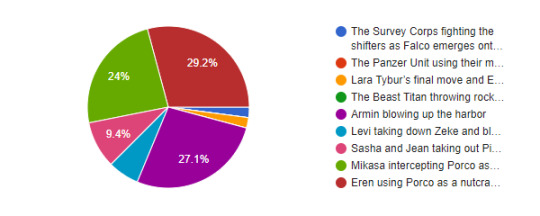
The most favored action moment among anime watchers, at 29.2%, was seeing Eren using Porco’s titan as a nutcracker to defeat Lady Tybur. Following closely behind, at 27.1%, people most enjoyed Armin’s reintroduction as he blew up the harbor with his Colossal atomic blast. 24% most enjoyed seeing Mikasa fillet Porco’s legs, and a small 9.4% felt the most hype when Sasha and Jean helped take the Cart Titan and the Panzer Unit out of the fight.
armin supremacy
WHICH OF THE FOLLOWING MOMENTS MADE YOU FEEL THE MOST EMOTIONAL? 95 Responses

In contrast to the action were the scenes that made us feel some emotions. 25.3% were most emotionally affected at Mikasa’s sorrow watching Eren doing something cruel to another human being. 26.8% felt the most for Armin in this episode as he looks down on the horrific aftermath of his explosion. 12.6% empathized most with Reiner as he made himself wake up despite still wishing to die. The remaining scenes that got people choked up, in order: Finally getting to see Hange again, Porco’s pleas as he’s forced to kill Lara Tybur, Gabi and Falco yelling out for Reiner to save Porco and help them, and Falco pleading with Jean not to kill Pieck.
Hange <3
ON A SCALE OF 1-5, HOW EERIE DID YOU FIND THIS IMAGE OF THE WAR HAMMER TITAN? 94 Responses
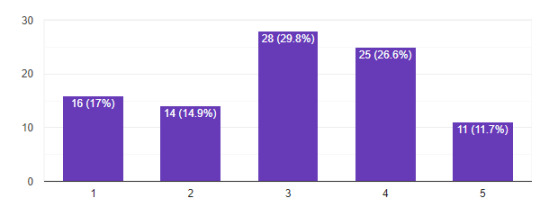
MAPPA drew an eerie shot of the War Hammer Titan near the beginning of the episode as she takes her final blow against Eren. Overall, people seemed to be neutral about the image, though more people found it to be closer to the stuff of nightmares than those who did not.
REGARDLESS OF HOW YOU FEEL ABOUT GABI’S CHARACTER, HER SEIYUU TRULY WENT ALL IN ON HER SCREAMS FOR REINER. ON A SCALE OF 1-5, HOW BONE CHILLING WAS HER PERFORMANCE? 93 Responses

The majority of anime viewers were taken aback by Gabi’s seiyuu’s performance, with 64.5% ranking it a 4 or 5. A smaller amount (14%) were less impressed by the acting and found the screams more annoying instead. 21.5% were more or less neutral.
Gaby's scream were... So desperate, so real.... I was chilled to the bones.
SOME FANDOM SPACES SEEM TO BE MORE POSITIVELY RECEPTIVE ABOUT THE CGI IN THIS EPISODE. WHERE DO YOU FALL ON THE SPECTRUM? 94 Responses
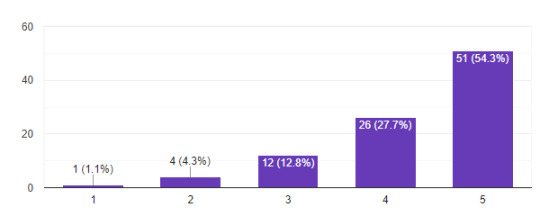
Overall, the reception to the CGI this episode has vastly improved over last week. 82% total felt that MAPPA’s use of CGI was a big improvement and that they continue to get better at it. Only 5 people felt more continued disappointment this week.
EREN MENTIONS THAT LARA TYBUR IS CRYSTALLIZED LIKE ANNIE, AND THAT HIS TEETH ARE USELESS AGAINST THAT. DOES THIS MEAN THAT THE SURVEY CORPS HAS TRIED TO HAVE ANNIE EATEN? 93 Responses
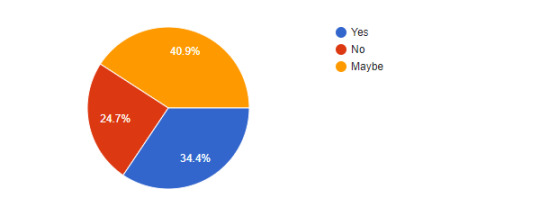
In general, respondents didn’t want to make a call either way about whether the Survey Corps has tried to have Annie eaten or not, with 40.9% voting a simple “maybe.” 34.4% believe that Eren’s words insinuated that he has experienced an attempt to eat a crystallized shifter before, while 24.7% feel certain that Annie has been left untouched all this time.
WE SEE EREN TRANSFORM FOR THE THIRD TIME IN A SHORT PERIOD IN THIS EPISODE, A STARK CONTRAST TO THE BEGINNING OF SEASON 3 WHEN HE COULDN’T DO SO WITHOUT HIS TITAN SEVERELY DEPLETING IN STRENGTH. WITH THIS, ALONG WITH HIS ABILITY TO REGENERATE QUICKLY BY HIS OWN WILL, HOW IMPRESSED ARE YOU WITH HIS MUCH IMPROVED ABILITY TO HANDLE HIS TITAN POWER? 92 Responses
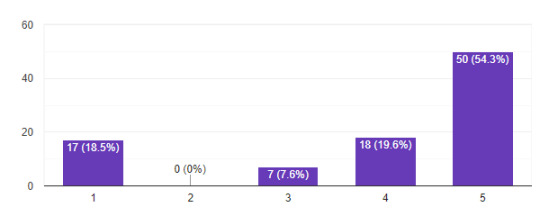
Eren has improved vastly in terms of controlling his titan power since the earlier seasons of the anime. 73.9% altogether felt very impressed with his improvement, while 18.5% didn’t think it was any big deal at all.
Eren is such a badass. I am totally proud of him.
ZEKE CRYPTICALLY DECLARED THAT EREN IS “NOT HIS ENEMY.” WHAT DO YOU THINK THIS MEANS? 90 Responses

We haven’t had a lot of insight into Zeke’s thoughts and feelings much this season, so hearing him declare Eren as not being his enemy may have taken some by surprise, though he quickly follows this statement up by stating Levi comes first. 34.4% of viewers believe that this was a heartfelt statement and that it has something to do with Zeke telling Eren back in Shiganshina that he was going to save him. 22.2% believe it was a dismissive statement and that Zeke didn’t see Eren as a threat so much as he wanted to deal with getting Levi out of the picture first. 15.6% took this as a signal that Zeke’s loyalties may not be with Marley at all. The remaining respondents have already been spoiled about future plot developments.
WE FINALLY GET TO SEE ARMIN - AND HIS COLOSSAL TITAN! WHICH COLOSSAL TITAN DESIGN DO YOU PREFER? 96 Responses

This episode marks the first time we get to see Armin’s Colossal Titan form, so we asked which design fans prefer between Armin and Bertolt. It came close, though the slight majority think that Armin’s Colossal design is just a bit better than Bertolt’s classic mascot design.
ARMIN ASKS, “ARE THESE THE SIGHTS THAT YOU SAW, BERTOLT?” DO YOU THINK HE HAS SEEN SOME OF BERTOLT’S MEMORIES? 90 Responses

The majority (62.2%) believe Armin’s words prove that he has seen some of Bertolt’s memories over the last few years. 27.8% aren’t sure and simply voted “maybe.” A small 10% feel certain that Armin hasn’t seen any of Bertolt’s memories and can merely only speculate about the horrors Bertolt witnessed as the Colossal Titan.
LEVI TOOK DOWN ZEKE RATHER EASILY. IS ZEKE DEAD? 89 Responses

Just about everyone, aside from those who are already spoiled about future happenings, believe that Zeke went down way too easily for it to be true. 55.1% believe that he has gone completely unscathed from Levi’s attack one way or another. 10.1% believe that he’s at least injured, just not dead. A small handful don’t want to make a call either way and just a tiny sliver of the pie believes that Zeke may actually be dead for real.
It is a plane
JEAN’S THUNDER SPEAR DOESN’T HIT FALCO AND PIECK. HE QUESTIONS HIMSELF ON WHETHER IT’S BECAUSE OF HIM OR BECAUSE OF THE STEAM PIECK EMITTED. WHAT DO YOU THINK? 89 Responses

We’ve seen Jean struggle to kill another person before, so it’s not surprising to see him struggle with it once again when said person is just a child begging for the carnage to stop. 65.2% of respondents feel that the reason the thunder spear missed was ultimately due to Jean’s hesitation and unwillingness to harm an innocent child. 22.5% believe he had steeled himself to kill Falco but was only thwarted by Pieck’s steam. Some feel unsure about what ultimately affected the outcome, though some write-ins think it’s a combination of both.
I think it's a combination of both, I think that the steam and his reluctance to kill an innocent child is what caused him to completely miss.
I think both
both
Both?
WHO IS ONYANKOPON? 89 Responses
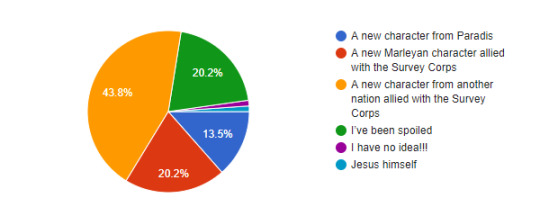
Hange and Armin were seen in the blimp with a new character named Onyankopon piloting it. But… where did he come from? 43.8% seem to believe that he is someone from another nation that has allied with the Survey Corps. 20.2% suspect that he is originally from Marley but has chosen to switch sides, and only 13.5% think that he’s a Paradis native we’ve never seen before.
I have no idea!!!
Jesus himself
WHERE DID THE SURVEY CORPS GET THE BLIMP? 89 Responses

Just as much as the new character is a mystery, so is the acquisition of an entire blimp! 30.3% believe that the blimp is something borrowed from an ally nation. 22.5% believe that it is stolen from Marley itself. 15.7% aren’t sure what to speculate, and only 11.2% believe that Paradis managed to figure this one out themselves.
WE SEE EREN’S TITAN SWALLOW THE BLOOD FROM LARA TYBUR. WHAT DO YOU THINK, DID HE SUCCESSFULLY STEAL THE WAR HAMMER TITAN’S POWER? 89 Responses
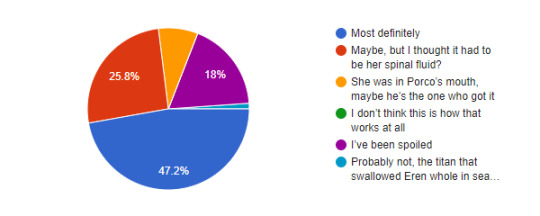
Nearly half of respondents are confident that Eren succeeded in his task to take the War Hammer Titan from the enemy. 25.8% think he most likely did, but are feeling confused as it’s been previously stated titans only transfer their power via spinal fluid. A small handful suspect there’s a possibility that Porco managed to swallow the necessary component to take the War Hammer instead of letting Eren have it.
Probably not, the titan that swallowed Eren whole in season 1 didn’t get his powers
%50 eren eat warhammer or %50 porco.
OVERALL, HOW DID IT MAKE YOU FEEL TO SEE EREN DOING SOMETHING SO COLD HEARTED? 90 Responses

Eren as a character has seemed a bit colder since the time skip, so we were curious about how people felt watching him assault Liberio and take out Lara Tybur the way he did. Reception of Eren’s actions is definitely a mixed bag. 27.8% are enjoying this new side of Eren, feeling he’s the “MF’ing GOAT.” 22.2% aren’t really sure how to feel about Eren’s actions yet and may need more context before making a final judgement. 20% just feel sad seeing Eren doing something so horrific, and 16.7% have lost any positive opinion they may have had about Eren at all.
Love to see Eren being a savage<3
Being given his rationale for his actions makes him a much more compelling character and I appreciate his gray morals more
It made me hate him, the way it felt to watch the Colossal and Armored Titans in Season 1.
Such is life
I think his character development is going in an interesting direction and I'm excited to get a more clear picture of why he's doing this in future episodes
I mean he always seemed to have a steak of evil in him since before. Kid killed people remorselessly, even if it was to save a girl. It was surprising from an audience point of view, but with his character, maybe it shouldn't really be too surprsing.
FALCO MENTIONS THAT PIECK’S BODY CAN’T HEAL FAST ENOUGH. DO YOU THINK SHE’LL MAKE IT OUT OF THIS ALIVE? 89 Responses

Pieck did not have such a good time this episode… Explosive injuries all around. When it comes to her fate in the next episode, a plurality (46.1%) seems to believe she’ll make it out alive, in contrast to 9% who think she’ll perish. Just under a quarter (23.6%) can’t be certain and 21.3% note that they’ve been spoiled already.
WHEN REINER AWAKENS, HIS ARMORED TITAN APPEARS TO TAKE ON A DIFFERENT FORM. THOUGHTS? 93 Responses
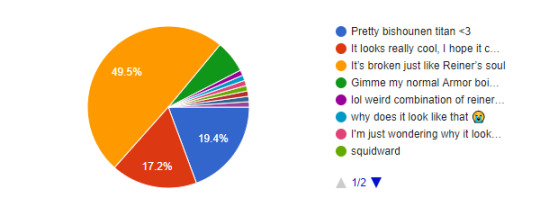
Reiner’s so handsome :3 and so is his Titan form this episode. An interesting development! What could it mean? Just under 50% seem to believe it represents how broken his soul is, 19.4% are just like the writer of these text blurbs and think the Titan form is cute. A little over 17% think it’s simply a rather cool structure and finally, a small minority are just yearning for his old form to return.
lol weird combination of reiner and titan i.e. when titan dies he ded
I'm just wondering why it looks so different.
squidward
Handsome squidward lol (I honestly don't have feelings on it either way)
why does it look like that 😭
Meh
Maybe he's weakened? The armors in his arms were also malformed.
DO YOU THINK PORCO WILL DIE NEXT EPISODE? 90 Responses

Porco was not treated well by this episode… Sheesh. Will the next episode do better by him? Well, just under 29% think he won’t die, at least. An equal amount of people believe he will, in fact, perish and were also spoiled about his fate (23.3%). 24.4% simply aren’t sure. Such an even pie chart!
THE NARRATIVE HAS LAID OUT A CLEAR FOUNDATION TO ALLOW THE AUDIENCE TO EMPATHIZE WITH CHARACTERS FROM BOTH SIDES OF THE SPECTRUM. WITH THE DEVELOPMENTS OF THIS ARC, WHICH SIDE OF THE CONFLICT DO YOU FIND YOURSELF EMPATHIZING WITH THE MOST AS A WHOLE? 90 Responses
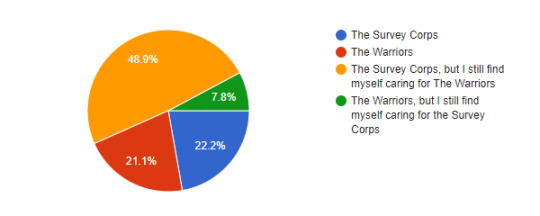
Sympathy and Empathy for everyone! When it comes to solely empathizing with one half of the cast, the results are rather close! 22.2% find themselves solely (or rather largely) attached to the old Survey Corps, in contrast to 21.1% who happen to solely (or rather largely) be attached to the new-ish Warriors. On the other hand, when mentioning the more “differing” options, 48.9% of responses noted that they find themselves more attached to the SC, while still caring for the Warriors, in contrast to the 7.8% stating the opposite.
I've grown to love the Warriors throughout this season but watching them get wrecked one by one like that was simply incredible...especially that dumbass Porco, he took the fattest L ever Idk how its possible but every episode gets better than the last one. Bless MAPPA!
Fuck the Warriors
ADDITIONAL THOUGHTS ON THE EPISODE?
It was Fire, finally Levi could take his revenge from zeke
Easily one of the best in the series. Mappa really found their feet with the CGI and it was clearly a mammoth task due to all the different titans and ODM scenes. Everything was so much cleaner this episode. I have not yet been majorly spoiled, so seeing Eren use Porco to kill Lara was literally so energizing, reminded of how I felt when I first watched SnK. Did everything go a little too smoothly for the Survey Corp? Yes. I want to believe our friends will win, but i have my doubts. Im excited to see how this battle will play out because I have know idea where it's heading.
Good god can Eren kill Gabi next she's freaking annoying xD
One of the Panzer Unit's members had in his cart area thingy.
Gave me what I wanted
I've never so afraid and sad while watching this series
WHERE DO YOU PRIMARILY DISCUSS THE SERIES? 91 Responses

Thank you again to everyone who participated!
15 notes
·
View notes
Text
A Bridge Too Far: Operation Market Garden 75 years on
In May 1945 it was the Russians who hoisted their flag over the ruins of the Reichstag building in Berlin. In this way World War Two, in Europe, was signalled as being effectively over. However, the troops who captured Berlin could easily have been British or American, if events around a small town in Holland had turned out differently.
Operation Market Garden, launched in September 1944, was an unsuccessful Allied offensive mainly, fought in the Netherlands. It was the largest airborne operation in history up to that time.

The operation was a daring one and it was the brainchild of the British General Bernard Montgomery. This operation was even the subject of the 1977 star studded movie A Bridge Too Far directed by Richard Attenborough. Montgomery intended the airborne offensive to allow the allies to break into the German heartland and to end the war, quickly. However, this was not the case, the allied offensive was to prove to be a costly failure and may have even delayed their victory in Europe.
Why did this operation fail? Was it Montgomery's over-optimistic planning, poor strategy, poor leadership, German resistance or the terrain?
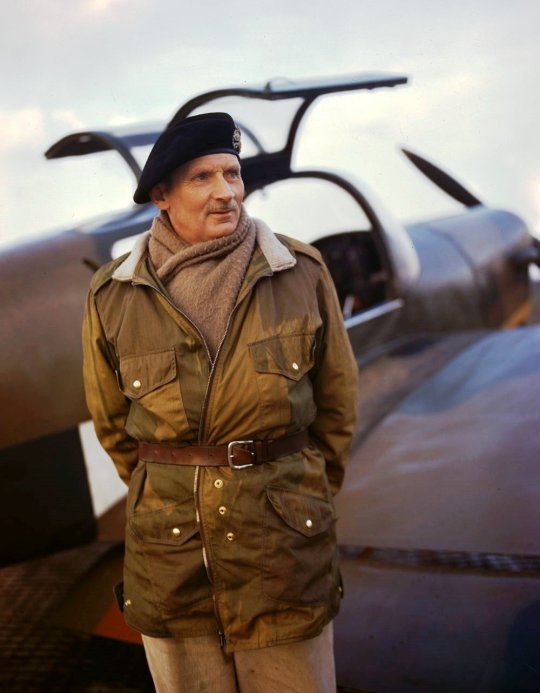
Background
The Allies had landed in Normandy on the 6th of June 1944. After establishing several beach heads in Normandy, the Allies managed to push forward into the Normandy countryside. The Germans initially managed to slow the Allies advance, however, a brilliant piece of Allied strategy, resulted in the encirclement of a large part of the German army, in the Falaise Pocket.
The combined Anglo-American divisions inflicted huge losses on the Germans. The German army was forced into a headlong retreat. Paris was soon retaken by the Allies. The German army was practically forced out of France and retreated towards Alsace-Lorraine and Belgium. It seemed to many that the Allies were on the verge of invading German and some even spoke optimistically of ending the war by Christmas.
However, in truth, the Allied successes had brought its own problems. The Allies supply lines were overstretched and this was slowing down the Americans and British in particular, the shortage of oil meant that Patton’s armored divisions had to halt their advance. This was to prove crucial and it allowed the Germans to regroup in the west, when it appeared that they would disintegrate, leading to the end of the war.

Reasons for Market Garden
By the Autumn of 1944, it was apparent to the Allied High Command that the Germans had managed to retrieve the situation and would offer stiff resistance to any future offensive. In August 1944, a British assault failed to take the deep water port of Antwerp and had allowed some 80,000 German troops from Scheldt Estuary.
This became known as the ‘Great Mistake’ and was perhaps one of the biggest in the entire war. The Allied high command was reluctant to attack the Germans from eastern France, as the German government had constructed a massive line of defenses, consisting of fortresses, to protect their western border, this was known as the Siegfried Line. The British and the Americans had to go through the Low Countries to invade Germany and end the war.
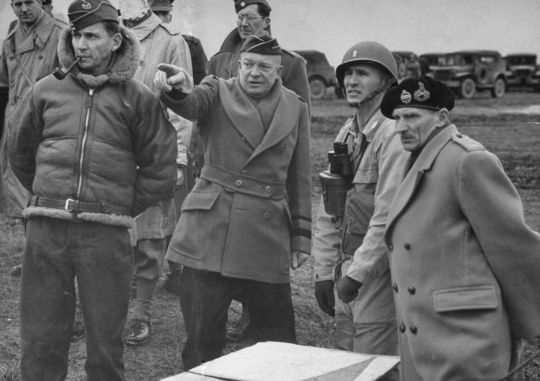
The Allies believed that they would need an innovative plan to break the German frontline in the Low Countries and in Alsace-Lorraine. General Eisenhower and other leaders turned their attention to the Low Countries. It offered them ports which could be used to re-supply the Allied divisions, who still were reliant on the Normandy ports for their supplies.
The more forward thinking of the allied strategists became concerned about the Rhine. This river would form a formidable natural barrier to any Allied advance but if they liberated the Low Countries it would allow them to cross the Rhine and then to cross into Northern Germany and then onto Berlin.
The American and the British governments became increasingly eager to end the War in Europe and they wanted to turn their attention to the Pacific War. Then the western allies believed that they were in a race to Berlin with the Soviet Army and they did not want the Red Army to capture all Germany and to turn it into a client state of Moscow.
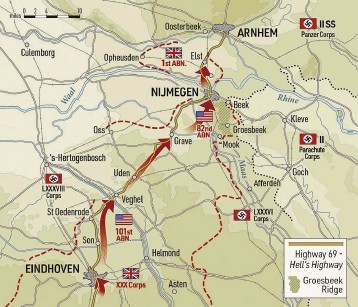
Montgomery's Strategy
The allies needed to break the Germans resistance and cross the Rhine in the Low Countries. General Bernard Montgomery, the hero of the British victory at EL Alamein, proposed a daring plan. Field Marshal Montgomery’s goal, as recounted in his memoirs was to invade Germany by securing the bridges over the Lower Rhine in the Netherlands.
This idea had several advantages such as by-passing the Siegfried Line. Montgomery wanted an airborne assault in the Netherlands to secure key bridges over the Lower Rhine. This would allow the Allies to enter into the Northern German plains, where there were no natural barriers, to their advance to Berlin.
Montgomery’s plan was initially more ambitious and it was rejected by General Eisenhower. Angered by Eisenhower's reluctance, Montgomery flew to Brussels that afternoon to meet him. Montgomery requested that Eisenhower's Chief Administrative Officer leave the meeting, while insisting that his own should remain. He then tore a file of Eisenhower's messages to shreds in front of him, argued for a concentrated northern thrust, and demanding priority in supplies. So fierce and unrestrained was Montgomery's language that Eisenhower suddenly reached out, patted Montgomery's knee and told him, "Steady, Monty! You can't talk to me like that. I'm your boss."
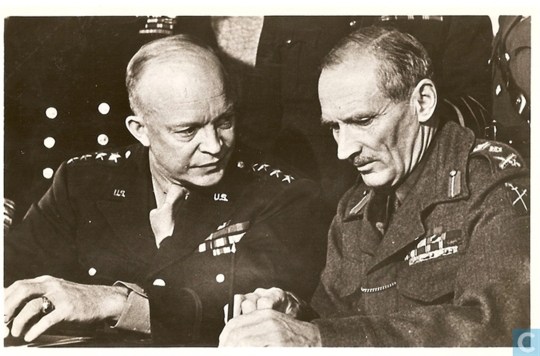
Eisenhower stated his belief that advance on a broad front would soon provoke German forces to collapse. He told Montgomery why a "single thrust" toward Berlin was not going to be accepted.
“What you're proposing is this – if I give you all the supplies you want, you could go straight to Berlin – right straight (500 miles) to Berlin? Monty, you're nuts. You can't do it. What the hell[?] ... If you try a long column like that in a single thrust you'd have to throw off division after division to protect your flanks from attack.”
Nevertheless, Eisenhower consented to Operation Market Garden after Montgomery scaled back his plans in response to Eisenhower’s criticism.
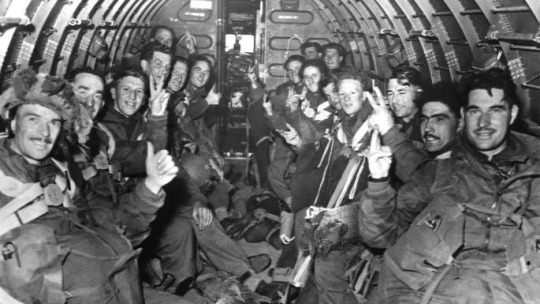
Montgomery proposed the following:
Airborne units would be dropped behind the German lines to secure the bridges over the Meuse and the two tributaries of the Rhine. The airborne units would hold the bridges until the British ground forces arrived. Montgomery believed that not only would this airborne operation succeed in securing bridges over the Rhine, but result in the retreat of German Divisions into Germany.
The Allied High Command agreed to the plan. Montgomery staked his reputation on the strategy and was backed by Churchill. The offensive was to be called Market Garden.
The 'Market' part of the operation involved the airborne aspect of the operation. The operation would involve four airborne divisions. The paratroopers would land in the area by gliders or they would parachute into the target zones.
Market Garden was to be executed by 41.628 English, American and Polish airborne troop and they would also be supplied with some light artillery. There were American, British and Polish units involved in the massive airdrops.
The ‘Garden’ part of the plan would involve several British Armored Divisions moving into the Netherlands to link up with the paratroopers and to defend the bridges from any German counterattack.
According to Montgomery, for the strategy to have worked it was dependent on two things, the quick capture of all the bridges by the Allies and the ground forces linking with the paratroopers, within days.

The Battle
Operation Market Garden began on the 17th of September 1944. It was a coordinated action by American, British a Polish Airborne and mainly British forces. The operation began with heavy air raids, in order to weaken any resistance. The paratroopers began landing at 13.00hrs around targets in the Netherlands, chiefly Eindhoven, Arnhem and Nijmegen. The paratroopers had the advantage of surprise and they achieved their objectives. The Germans had been taken completely by surprise.
The initial phase of the operation was a total success. It had been feared that the Germans would blow up the bridges and this would mean that the plan would have to be aborted. The rapid capture of the bridges meant that the ground forces would be able to reach the landing zones, and support the paratroopers.

The British ground forces fought their way to Nijmegen and captured the city, after some fierce fighting. One after another the bridges were captured by the British Ground forces. The operation appeared to be going to plan despite heavier than anticipated German resistance.
The most important bridge was Arnhem, this was the most strategically significant bridge and it had to be seized by the ground forces if Market Garden was to succeed in its objectives. The British paratroopers had captured the bridge but they soon came under fierce attack from units of the crack 9th and 10th SS Panzer Divisions. The SS had armor and tanks and they pounded the British paratroopers mercilessly.
The British paratroopers soon found themselves surrounded as the SS had encircled them. The lightly armed British soldiers fought bravely, but they could not hold out for long. An elite British unit, the Irish Guards, was fighting its way forward to help the airborne troops.
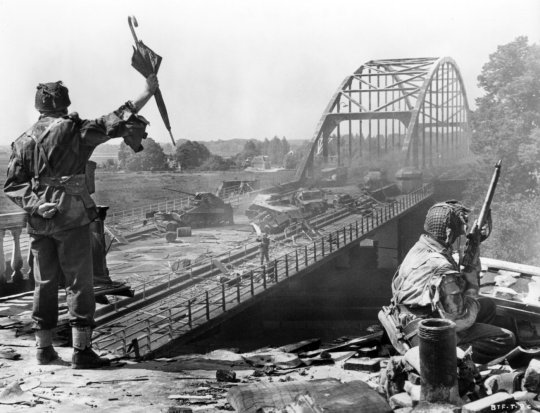
However, because of the terrain, they had to fight their way up to Arnhem on a single road and they were constantly attacked. This road came to be known as the Highway to Hell. The tanks of the Guards could not leave the narrow road as the ground was very marshy and much of it was bogland. As the Irish Guards made their way to Arnhem they were easily picked off by the Germans, who attacked them from the cover of woodland.
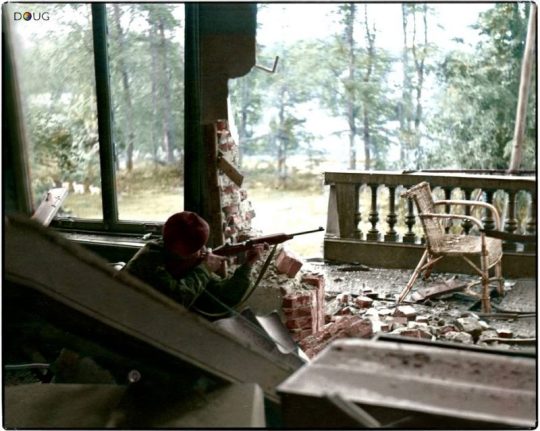
Eventually, such was the ferocity of the German resistance that the British came to a halt. The paratroopers at Arnhem were isolated and cut-off and were forced to surrender. Operation Market Garden had achieved all of its objectives, except the most important one, the capture of the Bridge at Arnhem.
Montgomery’s Optimistic Planning
Even before the start of the operation, many feared that Montgomery’s plan was too optimistic. The commander of the Polish airborne unit declared that the plan was flawed but went with it anyway.
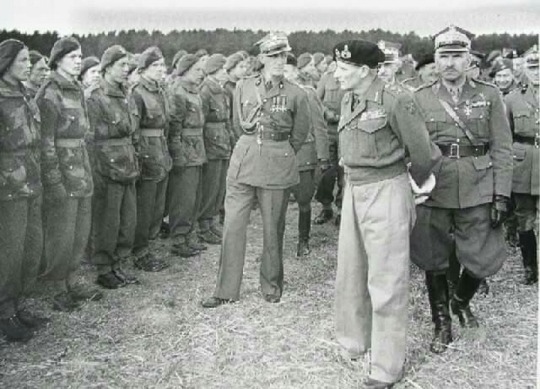
No one really knows who on Montgomery’s senior staff actually famously stated that the prime objective of the offensive the Arnhem Bridge was ‘a bridge too far.’ Whoever said it, he meant that Montgomery’s aims were simply too ambitious and that he was asking too much of his men.

Montgomery also assumed that the paratroop unit could retain their landing zones and the bridges for a given period of time. Paratroops were only lightly armed and without support from ground troops and tanks they could not hold out for long.
Lt-General Sir Frederick ‘Boy’ Browning - considered to be the father of the British Airborne forces and who comanded the 1st Airborne Corps - was wrong to believe that his airborne troops could resist assault from ground troops supported by armour for several days and did nothing to question Monty’s assumptions but reinforce them.

Crucially Montgomery and most of his senior staff failed to understand the terrain that he expected his men to fight in. The roads in the Netherlands were narrow and that the ground around them was unsuitable for armour. This was a fundamental error - Montgomery had simply assumed that his tanks could make their way rapidly to the landing zones, by using only the roads.
During the battle, the roads became death traps for many British units and they soon became clogged with burned-out tanks and vehicles and this critically delayed the ground forces coming to the support of the paratroopers in Arnhem, in particular. Perhaps the biggest failing of the Montgomery plan was that it assumed that the Germans had been decisively beaten and that any counter-attack that they could launch in the area would be limited.
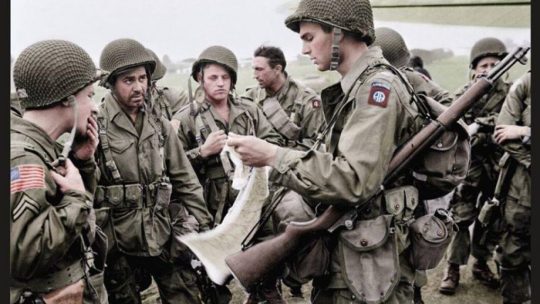
German Counter-attack
General Walter Model with SS-Brigadeführer Heinz Harmel The Germans had been driven back some two hundred miles in a matter of weeks. The British and the Americans dominated the skies and constantly harassed the Germans. Here the bravery and courage of the allied forces - 82nd and the 101st Airborne forces comes to mind as well as the Irish Guards.
The roads had become very unsafe for the Germans and they had also come under attack from the local resistance movements. The Germans had lost some 90,000 killed or wounded during the summer of 1944 and a further 200,000 had been taken prisoner or missing in action.

However, after the failure of the British army to encircle the German army in the Scheldt Estuary, allowed the Germans time to regroup in the Netherlands. The German front had begun to stabilise. They were also ably led by the very experienced General Walter Model. He also received some reinforcements in the form of the remaining units of the 9th and 10th SS Panzer Divisions.
Unfortunately, for the Allies, especially the British, the SS units were positioned in Arnhem. This was not merely bad luck, but due to good German intelligence.

Intelligence Failure
The Germans had anticipated that there would be an offensive launched with the objective of seizing Arnhem, Wesel, and Nijmegen. A senior intelligence officer argued that the British and the American would use airborne troops. However, he did not predict where the assault would be. Nevertheless, German intelligence was able to provide the High Command with the information they needed to prepare for any planned Allied attack. The German General Model heeded his intelligence officers and this was to prove decisive.

The British had excellent intelligence. They had reliable information on the movements of the Germans, from the Dutch Resistance and they could also employ aerial reconnaissance planes to obtain photographic intelligence. One reconnaissance mission was able to provide images that seemed to show German forces in the Arnhem area. This was confirmed by information from the local resistance. This was compelling proof that the Germans had significant forces and that any air assault on the region, would be a great risk.
It was Lt.Gen Frederick Browning who downplayed evidence brought to him by his intelligence officer, Major Brian Urquhart, that the 9th SS Panzer Division Hohenstaufen and the 10th SS Panzer Division Frundsberg were in the Arnhem area, but was not as confident as he led his subordinates to believe.
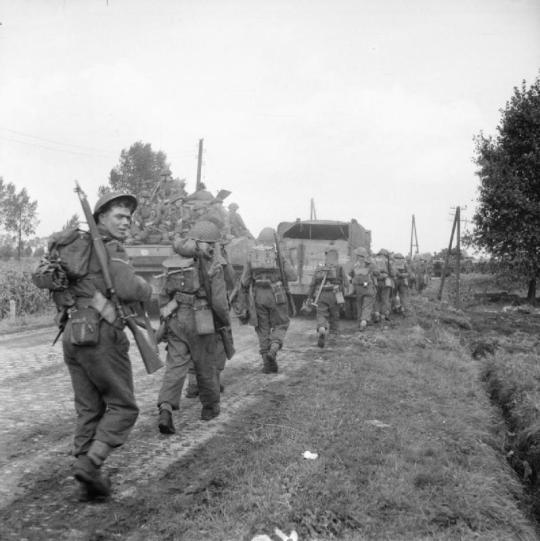
According to Major-General Urquhart, GOC of the British 1st Airborne Division, when informed that his airborne troops would have to hold the bridge for two days, Browning responded that they could hold it for four, but later claimed to Urquhart that he had added: "But I think we might be going a bridge too far."
When Major Brian Urquhart tried to report this up the chain of command to Montgomery, he was not believed. When Major Urquhart tried to persuade Browning and Montgomery that there was a large build-up of German forces near Arnhem, he was relieved of his command and rumours spread that he had a nervous breakdown. Montgomery’s refusal to heed intelligence was to result in a near disaster for the British. It appears that the he and his senior generals refused to countenance anything that contradicted Monty’s own views as he was utterly convinced of the brilliance of his plans for Market Garden and his own infallibility.

Consequences of Market Garden
The operation was not a total failure as it did lead to the liberation of large areas of southern Netherlands and gained hold of several strategic bridges. However, it failed to secure the key bridge at Arnhem, that would have allowed the Allies to cross the Rhine.
Quite simply, the failure at Arnhem meant that any planned invasion of Germany had to be delayed.

The Germans, although they had lost ground, were able to establish a strong defensive line. In total, the Allies had suffered some 15,000 casualties and had many thousands more taken prisoner. The Germans had also lost equipment and vehicles that they could ill-afford to use.
An unintended consequence of the offensive was a serious famine in the Netherlands. The Dutch railways stopped during the battle, to stop German reinforcements from getting to the front line. In revenge, the Germans forbade the transportation of food, by train and in the following winter there were serious food shortages throughout the Netherland’s and close to 20,000 died of starvation or malnutrition.

Conclusion: so near and yet so far
Operation Market Garden was a tactical defeat for the Allies, as it failed to achieve all its objectives. It failed to secure the key bridge at Arnhem and this meant that they were halted at the Rhine. This probably delayed the eventual Allied victory in western Europe.
The operation failed because of a failure in planning, intelligence, and a lack of understanding of the nature of the terrain.
While every previous major Allied operation had taken months if not years of meticulous planning, Market Garden was proposed in haste to try to take advantage of what appeared to be the German army retreating in disarray.
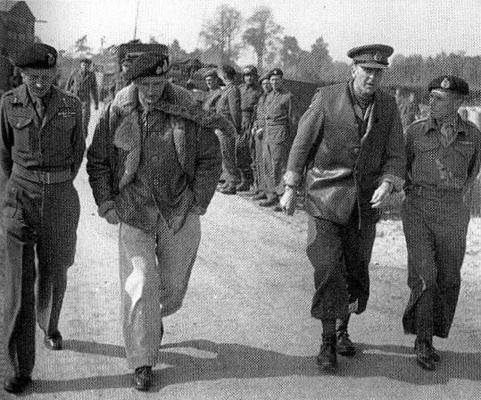
And the biggest blunder was landing 1st Airborne up to 13km away from the bridge, as paratroopers work best when they land right on top of their target, taking the defenders by surprise.
There was also a mistaken belief that the Germans had been all put defeated. Market Garden was moreover fundamentally flawed as it mistakenly believed that airborne forces could resist heavily armed troops for an extended period.
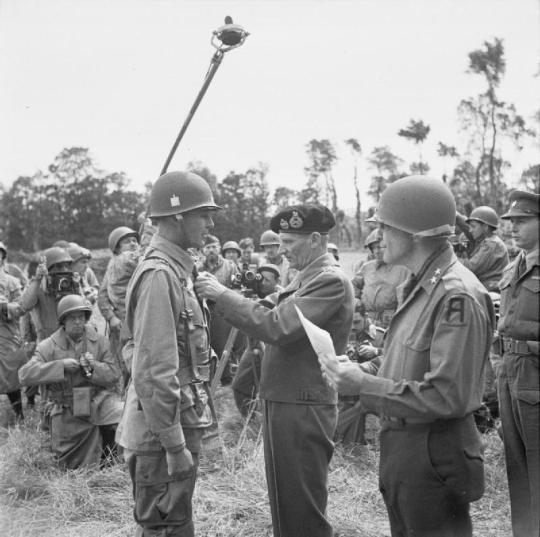
While not exclusively to blame, many of these failures were a result of Montgomery and his over-optimistic ideas and his arrogance. The failure of Operation Market Garden was largely the result of the poor leadership and tactics of General Montgomery. Monty admitted his mistake – the only time a senior Allied commander acknowledged a failure – but still claimed the operation was “90% successful”.
No one can say for sure who coined the phrase “a bridge too far” but it would have been more accurate to say Operation Market Garden was “too far from the bridge”.
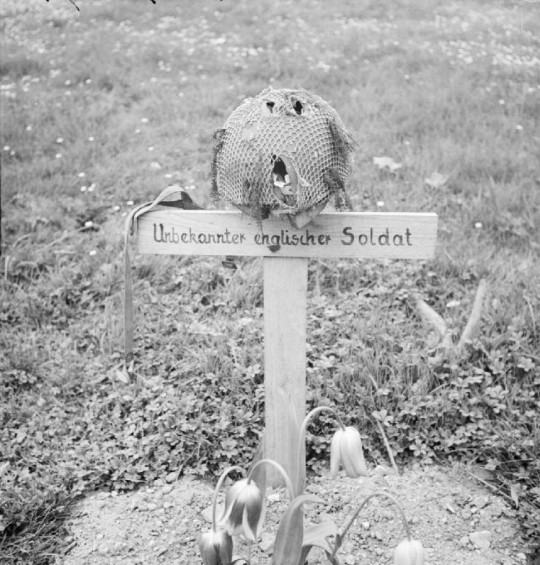
#operation market garden#market gaden#world war two#war#military history#history#montgomery#britain#america#europe#germany#netherlands#army#airborne
36 notes
·
View notes
Photo
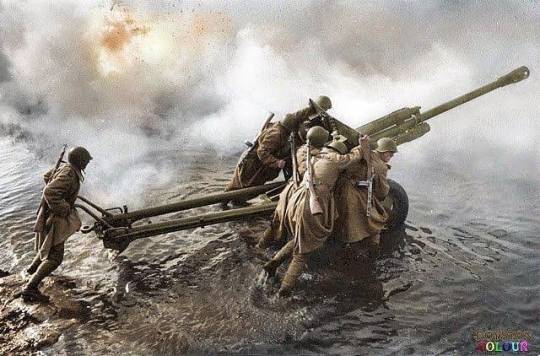
Soviet artillerymen transporting a 76-mm divisional gun M1942 (ZiS-3) during the forced crossing of the Oder River, Germany, c. December, 1944. . The Battle of the Oder–Neisse is the German name for the initial (operational) phase of one of the last two strategic offensives conducted by the Red Army in the Campaign in Central Europe (1 January – 9 May 1945) during World War II. Its initial breakthrough phase was fought over four days, from 16 April until 19 April 1945, within the larger context of the Battle of Berlin. . The battle included heavy fighting by the three Fronts of the Marshals of Soviet Union Konstantin Rokossovsky's 2nd Belorussian Front, Georgy Zhukov's 1st Belorussian Front and Ivan Konev's 1st Ukrainian Front, that assaulted the defending Wehrmacht Army Group Vistula commanded by Colonel-General (Generaloberst) Gotthard Heinrici and Field Marshal Ferdinand Schörner's Army Group Centre. . By the end of 19 April, the German eastern front line north of Frankfurt around the Seelow and to the south around Frost had ceased to exist. These breakthroughs allowed the two Red Army Fronts to envelop large parts of the German 9th and 4th Panzer Armies in a large pocket 37 km east of Frankfurt that attempted to follow the Oder-Spree Canal to Berlin. Attempts by the 9th Army to break out to the west would result in the Battle of Halbe. . The cost to the Red Army in making this initial breakthrough was very high. Between 1 April and 19 April, the Red Army lost over 2,807 tanks. During the same period, the Allies in the west lost 1,079 tanks. . (Photograph by Dmitri Baltermants. Colorized by Royston Leonardfrom the UK) https://www.instagram.com/p/Bn1j0C7Cp8L/?utm_source=ig_tumblr_share&igshid=hkvtcoubzypv
23 notes
·
View notes
Text
Best World War II Non-fiction History Books
ABRAMSKY, C. (ed.), Essays in Honour of E. H. Carr ('The Initiation of the Negotiations Leading to the Nazi-Soviet Pact: A Historical Problem’, D. C. Watt) Macmillan, 1974
ABYZOV, VLADIMIR, The Final Assault, Novosti, Moscow, 1985
ALEXANDROV, VICTOR, The Kremlin, Nerve-Centre of Russian History, George Allen 8: Unwin, 1963
ALLILUYEVA, SVETLANA, Only One Year, Hutchinson, 1969
Twenty Letters to a Friend, Hutchinson, 1967
AMORT, R., and JEDLICKA, I. M., The Canan's File, Wingate, 1974
ANDERS, LIEUTENANT-GENERAL W., An Army in Exile, Macmillan, 1949
ANDREAS-FRIEDRICH, RUTH, Berlin Underground, 1939-1945, Latimer House, 1948
ANON, A Short History of the Bulgarian Communist Party, Sofia Press, Sofia, 1977
ANON, The Crime of Katyn, Facts and Documents, Polish Cultural Foundation, 1965
ANON, The Obersalzberg and the Third Reich, Plenk Verlag, Berchtesgaden, 1982
ANTONOV-OUSEYENKO, ANTON, The Time of Stalin, Portrait of a Tyranny, Harper & Row, New York, 1981
BACON, WALTER, Finland, Hale, 1970
BARBUSSE, HENRI, Stalin: A New World Seen Through One Man, Macmillan, New York, 1935
BAYNES, N. H. (ed), Hitler’s Speeches, 1922-39, 2 vols, OUP, 1942
BEAUFRE, ANDRE, 1940: The Fall of France, Cassell, 1968
BECK, JOSEF, Demier Rapport, La Baconniére, Brussels, 1951
BEDELL SMITH, WALTER, Moscow Mission 1946-1949, Heinemann, 1950
BELOFF, MAX, The Foreign Policy of Soviet Russia, Vol Two, 1936-1941, Oxford, 1949
BEREZHKOV, VALENTIN, History in the Making, Progress Publishers, Moscow, 1983
BIALER, S., Stalin and His Generals, Souvenir Press, 1969
BIELENBERG, CHRISTABEL, The Past is Myself, Chatto & Windus, 1968
BIRKENHEAD, LORD, Halifax, Hamish Hamilton, 1965
BOHLEN, CHARLES E., Witness to History, 1929-1969, Weidenfeld & Nicolson, 1973
BONNET, GEORGES, Fin d’une Europe, Geneva, 1948
BOURKE-WHITE, MARGARET, Shooting the Russian War, Simon 8: Schuster, New York, 1942
BOYD, CARL, Magic and the Japanese Ambassador to Berlin, Paper for Northern Great Plains History Conference, Eau Claire, Wisconsin, 1986
BUBER, MARGARETE, Under Two Dictators, Gollancz, 1949
BUBER-NEUMANN, MARGARETE, Von Potsdam nach Moskau Stationens eines Irrweges, Hohenheim, Cologne, 1981
BULLOCK, ALAN, Hitler: A Study in Tyranny, Pelican, 1962
BURCKHARDT, CARL I., Meine Danziger Mission, 1937- 1939, Munich, 1960
BUTLERJ. R. M. (editor), Grand Strategy, Vols I-III, HMSO, 1956-1964
BUTSON, T. G., The Tsar’s Lieutenant: The Soviet Marshal, Praeger, 1984
CALDWELL, ERSKINE, All Out on the Road to Smolensk, Duell, Sloan and Pearce, New York, 1942
CALIC, EDOUARD, Unmasked: Two Confidential Interviews with Hitler in 1931, Chatto & Windus, 1971
CARELL, PAUL, Hitler’s War on Russia, Harrap, 1964
CASSIDY, HENRY C., Moscow Dateline, Houghton Mifilin, Boston, 1943
CECIL, ROBERT, Hitler’s Decision to Invade Russia, 1941, Davis-Poynter, 1975
CHANEY, OTTO PRESTON, JR., Zhukov, David & Charles, Newton Abbot, 1972
CHAPMAN, GUY, Why France Collapsed, Cassell, 1968
CHURCHILL, WINSTON S., The Second World War. Vol. I: The Gathering Storm, Vol. II: Their Finest Hour, Vol. III: The Grand Alliance, Penguin, 1985
CIENCIALA, ANNA M., Poland and the Western Powers, Routledge & Kegan Paul, 1968
CLARK, ALAN, Barbarossa, Hutchinson, 1965
COATES, W. P. and Z. K., The Soviet-Finnish Campaign, Eldon Press, 1942
COHEN, STEPHEN (ed.), An End to Silence (from Roy Medvedev’s underground magazine, Political Diary), W. W. Norton, New York, 1982
COLLIER, RICHARD, 1940 The World in Flames, Hamish Hamilton, 1979
COLVILLE, JOHN, The Fringes of Power, Downing Street Diaries, 1939-1955, Hodder & Stoughton, 1985
COLVIN, IAN, The Chamberlain Cabinet, Gollancz, 1971
CONQUEST, ROBERT, The Great Terror: Stalin’s Purge of the Thirties, Macmillan, 1968
COOKE, RONALD C., and NESBIT, ROY CONGERS, Target: Hitler’s Oil, Kitnber, 1985
COOPER, DIANA, Autobiography, Michael Russell, 1979
COULONDRE, ROBERT, De Staline a Hitler, Paris, 1950
CRUIKSHANK, CHARLES, Deception in World War II, CUP, 1979
DAHLERUS, BIRGER, The Last Attempt, Hutchinson, 1948
DALADIER, EDOUARD, The Defence of France, Hutchinson, 1939
DEAKIN, F. W., and STORRY, G. R., The Case of Richard Sarge, Chatto 8: Windus, 1966
DEIGHTON, LEN, Blitzkrieg, Jonathan Cape, 1979
DELBARS, YVES, The Real Stalin, George Allen 8: Unwin, 1953
DEUTSCHER, ISAAC, Stalin. A Political Biography, CUP, 1949
DIETRICH, OTTO, The Hitler I Knew, Methuen, 1957
DILKS, DAVID, (ed.), Diaries of Sir Alexander Cadogan 1938-1945, Cassell, 1971
DJILAS, MILOVAN, Conversations with Stalin, Penguin, 1963
DOBSON, CHRISTOPHER and MILLER, JOHN, The Day We Almost Bombed Moscow: Allied War in Russia 1918-1920, Hodder & Stoughton, 1986
DOLLMANN, EUGEN, The Interpreter, Hutchinson, 1967
DONNELLY, DESMOND, Struggle for the World, Collins, 1965
DOUGLAS, CLARK, Three Days to Catastrophe, Hammond, 1966
DRAX, ADMIRAL SIR REGINALD PLUNKETT-ERNLE-ERLE-, Mission to Moscow, August 1939, Privately, 1966
DREA, EDWARD J., Nomohan: Japanese-Soviet Tactical Combat. 1939, Combat Studies Institute, Leavenworth Papers, January 1981
EDEN, ANTHONY, Facing the Dictators, Cassell, 1962
The Reckoning, Cassell, 1965
EDMONDS, H.J., Norman Dewhurst, MC, Privately, Brussels, 1968
EHRENBURG, ILYA, Eve of War, MacGibbon & Kee, 1963
EINZIG, PAUL, In the Centre of Things, Hutchinson, 1960
EISENSTEIN, SERGEI M., Immoral Memories, Peter Owen, 1985
ENGEL, GERHARD, Heeresadjutant bei Hitler 1938-1943, Deutsche Verlags-Anstalt,
Stuttgart, 1974
ERICKSON,J., The Road to Stalingrad Weidenfeld & Nicolson, 1975
The Soviet High Command, Macmillan, 1962 ‘Reflections on Securing the Soviet Far Eastern Frontier: 1932-1945’, Interplay, August-September 1969
EUGLE, E., and PAANEN, L., The Winter War, Sidgwick 8: Jackson, 1973
FEILING, KEITH, The Life of Neville Chamberlain, Macmillan, 1946 FESTJOACHIM C., Hitler, Harcourt Brace Jovanovich, New York, 1974
The Face of the Third Reich, Weidenfeld 8c Nicolson, 1970
FISCHER, ERNST, An Opposing Man, Allen Lane, 1974
FLANNERY, HARRY W., Assignment to Berlin, Michael Joseph, 1942
FLEISHER, WILFRID, Volcano Isle, Jonathan Cape, 1942
FOOTE, ALEXANDER, Handbook for Spies, Museum Press, 1949, 1953
FRANCOIS-PONCET, ANDRE, The Fateful Years, Gollancz, 1949
FRANKEL, ANDREW, The Eagle’s Nest, Plenk Verlag, Berchtesgaden, 1983
GAFENCU, GRIGOIRE, The Last Days of Europe, Frederick Muller, 1947
GALANTE, PIERRE, Hitler Lives and the Generals Die, Sidgwick 8: Jackson, 1982
GARLINSKI, JOZEF, The Swiss Corridor, J. M. Dent, 1981
GIBSON, HUGH (ed.), The Ciano Diaries, 1939-1 943, Doubleday, New York, 1946
GILBERT, MARTIN, Finest Hour, Heinemann, 1983
The Holocaust, TheJewish Tragedy, Collins, 1986
Winston Churchill, The Wildemess Years, Macmillan, 1981
GISEVIUS, HANS BERND, To the Bitter End, Cape, 1948
GORALSKI, ROBERT, World War II Almanac, 1931-1945, Hamish Hamilton, 1981
GORBATOV, ALEKSANDR v., Years Of My Lips, Constable, 1964
GORODETSKY, G., Stahhrd Cripps’Mission to Moscow, 1940-42, Cambridge U.P., 1984
GREW, JOSEPH C., Ten Years in Japan, Hammond, Hammond, 1945
GREY, IAN, Stalin, Man of History, Weidenfeld 8c Nicolson, 1979
The First Fijiy Years. Soviet Russia, 1917-1967, Hodder 8c Stoughton, 1967
GRIGORENKO, PETRO G., Memoirs, Harvill, 1983 GRIPENBERG, G. A. (trs. Albin T. Anderson), Finland and the Great Powers, Univ. Of
Nebraska Press, Lincoln, 1965
GUDERIAN, HEINZ, Panzer Leader, Ballantine Books, New York
GUN, NERIN E., Eva Braun, Hitler’s Mistress, Frewin, 1968
HALDER, COLONEL-GENERAL FRANZ, Kriegstagehuch, Kohlhammer, Stuttgart, 1963 Hitler als Feldherr, Miinchener Dom-Verlag, Munich, 1949
HALIFAX, LORD, Fulness of Days, Collins, 1957
HARLEYJ. H. (based on Polish by Conrad Wrzos), TheAuthentic Biography of Colonel Beck, Hutchinson, 1939
HARRIMAN, W. A., and ABEL, 13., Special Envoy to Churchill and Stalin, 1941-1946, Random House, New York, 1975
HASLAM,J., The Soviet Union and the Struggle/or Collective Security in Europe, 1933-1939, Macmillan, 1984
HAUNER, MILAN, Hitler. A Chronology of His Life and Time, Macmillan, 1983
HAYASHI, SABURO (with ALVIN D. coox), Kogun, The ]apanese Army in the Pacific War, Marine Corps Association, Quantico, Va., 1959
HEIBER, HELMUT, Goebbels, Robert Hale, 1972
HENDERSON, SIR NEVILE, Failure of a Mission, Hodder & Stoughton, 1940
HERWARTH, HANS VON (with FREDERICH STARR), Against Two Evils, Collins, 1981
HESSE, FRITZ, Das Spiel um Deutschland, List, Munich, 1953 Hitler and the English, Wingate, 1954
HESTON, LEONARD and RENATO, The Medical Case Boole of Adolf Hitler, Kimber, 1979
HILGER, GUSTAV (with ALFRED G. MEYER), The Incompatible Allies: A Memoir-History of German-Soviet Relations, 1918-1941 Macmillan, New York, 1953
HILL, LEONIDAS E. (ed.) Die Weizsacleer Papiere, 1933-1950, Berlin, 1974
HINSLEY, F. H. with THOMAS, E. E., RANSOM, C. F. G., and KNIGHT, R. (3., British Intelligence in the Second World War, Vol. 1, HMSO, 1979
HITLER, ADOLF, Mein Kampf, Hutchinson, 1969 Hitler’s Secret Conversations, Signet, New York, 1961 The Testament of Adolf Hitler. The Hitler-Borrnann Documents, Cassell, 1961
HOFFMANN, HEINRICH, Hitler Was My Friend, Burke, 1955
HOFFMANN, PETER, Hitler’s Personal Security, MIT, Boston, 1979
HOHNE, HEINZ (trs. R. Barry), The Order of the Death ’5 Head: The Story of Hitler’s SS, Seeker & Warburg, 1969 HOSKING, G., A History of the Soviet Union, Fontana, 1985 HYDE, H. MONTGOMERY, Stalin, Rupert Hart-Davis, 1971 INFIELD, GLENN B., Hitler’s Secret Life, Hamlyn, 1980 IRVING, DAVID, Hitler’s War, 1939-1942, Macmillan, 1983 The War Path, Michael Joseph, 1978
ISRAELYAN, V. L., The Diplomatic History of the Great Fatherland War, Moscow, 1959
JAKOBSON, MAX, The Diplomacy of the Winter War, Harvard UP, Boston, 1961
JEDRZEJEWICZ, WACLAW (ed.), Diplomat in Paris: 1931-1939 -Papers 65 Memoirs of ]uliusz Lukasiewicz, Columbia UP, New York, 1970
JONES, F. C., Japan’s New Order in East Asia. Its Rise and Fall, 0UP, 1954 Manchuria Since 1931, Royal Institute of International Affairs, 1949
JONES, R. V., Most Secret War, Hamish Hamilton, 1978
JONGE, ALEX DE, Stalin and the Shaping of the Soviet Union, Collins, 1986 The Weimar Chronicle. Prelude to Hitler, Paddington Press, 1978
KAZAKOV, GENERAL M. I., Nad Kartoi Bylykh Srazhenii, Voenizdat, Moscow, 1965
KEITEL, WILHELM, Memoirs, Kimber, 1965
KENNAN, GEORGE E, Soviet Foreign Policy 1917-1941, Robert E. Krieger, Princeton, 1960
KHRUSHCHEV, NIKITA S., (Trs. and edited by Strobe Talbott), Khrushchev Remembers, André Deutsch, 1971
KIRBY, D. G., Finland in the Twentieth Century, C. Hurst 8t Co., 1979
KIRKPATRICK, LYMAN B. JR, Captains Without Eyes. Intelligence Failures in World War II, Macmillan, New York
KLEIST, PETER, European Tragedy, Times Press/Anthony Gibbs & Phillips, Isle of Man, 1965
KORDT, ERICH, Nicht aus den Akten: Die Wilhelrnstrasse in Frieden und Krieg, Stuttgart, 1950
KRAVCHENKO, VICTOR, I Chose Freedom, Robert Hale, 1947
KROSBY, HANS PETER, Finland, Germany and the Soviet Union, 1940-41: The Petsamo Dispute, Univ. of Wisconsin, Madison, 1968
KRYLOV, IVAN, Soviet Staff Officer, Falcon Press, 1951
KUBIZEK, AUGUST, The Young Hitler I Knew, Houghton, Mifflin, Boston, 1955
KUSNIERZ, B. N., Stalin and the Poles, Hollis & Carter, 1949
KUUSINEN, AINO, Before and After Stalin, Michael Joseph, 1974
KUZNETSOV, N. G., ‘In Charge of the Navy’ (from Stalin and His Generals, ed. Seweryn Bialer), Souvenir Press, 1969
LEACH, BARRY A., German Strategy Against Russia, 1939 - 1941, OUP, 1973
LEHMAN, JEAN-PIERRE, The Roots of Modern Japan, Macmillan, 1982
LENSEN, GEORGE ALEXANDER, The Strange Neutrality. Soviet-Japanese Relations During the Second World War 1941-1945, Diplomatic Press, Tallahassee, Fla., 1972
LEONHARD, WOLFGANG, Child of the Revolution, Collins, 1957
LEWIN, RONALD, Hitler’s Mistakes, Leo Cooper, 1984 Ultra Goes to War, Hutchinson, 1978
LITVINOV, MAXIM, Notes for a Journal, André Deutsch, 1955
LITYNSKI, ZYGMUNT, I Was One of Them, Cape, 1941
LOSSBERG, BERNHARD VON, Im Wehnnachtfuhrungsstab, Nolke, Hamburg, 1947
LUKACS JOHN, The Last European War, Routledge & Kegan Paul, 1977
LYONS, GRAHAM (ed.), The Russian Version of the Second World War, Leo Cooper, 1976
MACKENZIE, A., The History of Transylvania, Unified Printers 8: Publishers, 1983
MACKIEWICZ, STANISLAW, Colonel Beck and His Polity, Eyre & Spottiswoode, 1944
MACKINTOSH, M., Juggernaut. A History of the Soviet Armed Forces, Seeker 8t Warburg, 1967
MACLEAN, FlTZROY, Eastern Approaches, Cape, 1949
MACLEOD, COLONEL R., and KELLY, DENIS (eds.), The Ironside Diaries, 1937-1940, Constable, 1962
MAISKY, IVAN, Memoirs of a Soviet Ambassador, Hutchinson, 1967 Who Helped Hitler?, Hutchinson, 1964
MANCHESTER, WILLIAM, The Arms of Krupp, Michael Joseph, 1969
MANVELL, ROGER, and FRAENKEL, HEINRICH, Hitler, the Man and the Myth, Granada, 1978
MEDVEDEV, ROY, All Stalin 3 Men, Blackwell, Oxford, 1983 Let History Judge, Alfred A. Knopf, New York, 1971 Khrushchev, Blackwell, Oxford, 1982 On Stalin and Stalinism, CUP, 1979
MERSON, ALLAN, Communist Resistance in Nazi Germany, Lawrence & Wishart, 1985
MORAVEC, FRANTISEK, Master of Spies, Bodley Head, 1975
MORLEY, JAMES W. (ed.), The Fateful Choice: Japan ’s Road to the Pacific War, Columbia UP, New York, 1980
MOSLEY, LEONARD, On Borrowed Time, Weidenfeld & Nicolson, 1969
NEKRICH, A. M., 1941, 22 Iyunia, Nauka, Moscow, 1965
NOLLAU, GUNTHER, International Communism and World Revolution, Hollis & Carter, 1961
NOWAK, JAN, Courier from Warsaw, Collins/Hamill, 1982
OTETEA, ANDREI, The History of the Romanian People, Scientific Publishing House, Bucharest, 1970
OVSYANY, IGOR, The Origins of Word War Two, Novosti, Moscow, 1984
PAASIKIVI, JUHO KUSTI, Am Rande einer Supermacht, Behauptung durch Diplomatie, Hosten Verlag, Hamburg, 1966
PARKINSON, ROGER, Peace for Our Time, Hart-Davis, 1971
PAYNE, ROBERT, The Rise and Fall of Stalin, W. H. Allen, 1966
PETROV, VLADIMIR, June 22, 1941. Soviet Historians and the German Invasion, Univ. of S. Carolina, 1968
RACZYNSKI, COUNT EDWARD, In Allied London, Weidenfeld & Nicolson, 1962
RADO, SANDOR, Sous le Pseudonym Dora (Dora Jelenti), Julliard, Paris, 1972
RAEDER, ERICH, My Life, US Naval Institute, Annapolis, 1960
READ, ANTHONY, and FISHER, DAVID, Colonel Z, Hodder & Stoughton, 1984 Operation Lucy, Hodder & Stoughton, 1980
REISCHAUER, EDWIN O., The Japanese, Harvard UP, 1977
REITLINGER, GERALD, The House Built on Sand, Weidenfeld & Nicolson, 1960
RIBBENTROP, JOACHIM VON, Zwischen London und Moskau: Erinnerungen und letzte Aufzeichnungen, Stuttgart, 1955
RICH, NORMAN, Hitler’s War Aims: Ideology, the Nazi State and the Course of Expansion, Norton, New York, 1973 Hitler’s War Aims: The Establishment of the New Order, Norton, New York, 1974
RINGS, WERNER, Life with the Enemy, Weidenfeld & Nicolson, 1982
ROKOSSOVSKY, K., A Soldier’s Duty, Progress Publishers, Moscow, 1970
ROOS, H., A History of Modern Poland, Eyre & Spottiswoode, 1962
ROSSI, A., The Russo-German Alliance, Chapman 8: Hall, 1950
ROTHSTEIN, ANDREW, and DUTT, CLEMENS (eds.), History of the Communist Party of the Soviet Union, Foreign Languages Publishing House, Moscow
RUBINSTEIN, ALVIN Z. (ed.), The Foreign Policy of the Soviet Union. The Search for Security 1934-41, New York, undated
RUSSELL, WILLIAM, Berlin Embassy, Michael Joseph, 1942
RYABOV, VASILI, The Great Victory, Novosti, Moscow, 1985
SALISBURY, HARRISON E., A journey for Our Times, Harper 81. Row, New York, 1983 The Siege of Leningrad, Seeker & Warburg, 1969
SCHAPIRO, LEONARD, The Government and Politics of the Soviet Union, Vintage Books, 1978
SCHMIDT, PAUL, Hitler’s Interpreter, Heinemann, 1951 SCHRAMM, PERCY ERNST, Hitler: The Man and the Military Leader, Allen Lane, 1972 SCHREIBER, H., Teuton and Slav, 1965
SCHWARZ, PAUL, This Man Ribhentrop, julian Messner, New York, 1943
SCOTT, JOHN, Duel for Europe, Houghton Mifflin, Boston, 1942
SEATON, ALBERT, The Russo-German War 1941-45, Arthur Barker, 1971 Stalin as Warlord, Batsford, 1976
SEVOSTYANOV, PAVEL, Before the Nazi Invasion, Progress, Moscow, 1984
SEYMOUR, CHARLES (ed.), The Intimate Paper of Colonel House, Houghton Mifflin, Boston, 1926
SHACHTMAN, TOM, The Phony War 1939-1940, Harper & Row, New York, 1982
SHIRER, WILLIAM, Berlin Diary, Bonanza Books, New York, 1984 The Nightmare Years, 1930-1940, Little, Brown, ‘Boston, 1984 The Rise and Fall of the Third Reich, Secker & Warburg, 1960 The Collapse of the Third Republic, Literary Guild, 1966
SHOSTAKOVICH, DMITRI, Testimony, Hamish Hamilton, 1979
SIPOLS, V. J., Secret Diplomacy. Bourgeois Latvia in the Anti-Soviet Plans of the Imperialist Powers, 1919-1940, Riga The Road to Victory, Progress, Moscow, 1985
SMITH, HOWARD K., Last Train from Berlin, Cresset Press, 1942
SOMMER, ERICH F., Das Memorandum, Herbig, Munich, 1981
SOUVARINE, BORIS, Stalin-A Critical Survey of Bolshevism, Longmans, Green, New York, 1939
SPEER, ALBERT, Inside the Third Reich, Weidenfeld & Nicolson, 1970
STALIN, J. V., The Great Patriotic War of the Soviet Union, International Publishers, New York, 1948
STERN, J. P., Hitler. The Fuhrer and the People, Fontana, 1975
STONE, NORMAN, Hitler, Hodder & Stoughton, 1980
STORRY, RICHARD, A History of Modern Japan, Penguin Books, 1960 Japan and the Decline of the West in Asia 1894-1943, Macmillan, 1979
STRANG, LORD, The Moscow Negotiations 1939, Leeds UP, 1968 Home and Abroad, André Deutsch, 1956
STYPULKOWSKI, Z., Invitation to Moscow, Thames & Hudson, 1951
SUKHANOV, N. N., The Russian Revolution, 1917, CUP, 1955
SUVOROV, VIKTOR, Soviet Military Intelligence, Hamish Hamilton, 1984
SYROP, KONRAD, Poland in Perspective, Robert Hale, 1982
SZEMBEK, JAN, Journal, 1933-1939, Léon Noel, Paris, 1952
TANNER, V., The Winter War, Stanford UP, 1957
TARULIS, ALBERT N., Soviet Policy Toward the Baltic States, 1918-1944, Univ. of Notre Dame Press, 1959
TAYLOR, A.J. P., The Origins of the Second World War, Penguin, 1961 The Second World War, Hamish Hamilton, 1975
TAYLOR, FRED (ed.), The Goebbels Diaries 1939-41, Hamish Hamilton, 1982
THAYER, CHARLES, Diplomat, Harper, New York, 1959
THOMI, ABRAHAM, The Dream and the Awakening, Gareth Powell Associates, Sydney, 1977
TOKAEV, G., Comrade X, Harris Press, 1956
TOLAND, JOHN, Adolf Hitler, Doubleday, New York, 1976
The Rising Sun. The Decline and Fall of the Japanese Empire, 1936-1945, Cassell, 1970
TROTSKY, LEON, My Life, Grosset & Dunlap, New York, 1960
Stalin: An Appraisal of the Man and his Influence, Harper, New York, 1941
TUOMINEN, ARVO, The Bells of the Kremlin, Univ. Press of New England, 1983
ULAM, ADAM B., Expansion and Coexistence. Soviet Foreign Policy, 1917-73, Praeger Publishers, New York, 1974
Stalin, the Man and his Era, Allen Lane, 1974
UPTON, A. F., Finland 1939-40, Davis-Poynter, 1974
Finland in Crisis, 1940-1941, Faber & Faber, 1964
The Communist Parties of Scandinavia and Finland, Weidenfeld & Nicolson, 1973
URBAN, GARRI S., Tovarisch, I am not Dead, Weidenfeld & Nicolson, 1980
VANSITTART, LORD, The Mist Procession, Hutchinson, 1958
VARDYS, V. STANLEY (ed.), Lithuania Under the Soviets 1940-1965: Aggression Soviet Style 1939-1940, Frederick Praeger, New York, 1965
VIGOR, P. H., Soviet Blitzkrieg Theory, Macmillan, 1983
VOLKOV, FYDOR, Secrets from Whitehall and Downing Street, Progress Publishers, Moscow, 1980
VORMANN, NIKOLAUS VON, Der Feldzug in Polen, I93 9, Weissenburg, 1958
VORONOV, N. N., Na Sluzhbe Voennoi, Moscow, 1963
WALLER, BRUCE, Bismarck at the Crossroads, Athlone Press, 1974
WARLIMONT, WALTER, Inside Hitler’s Headquarters, 1939-45, Weidenfeld & Nicolson, 1964
WATT, DONALD CAMERON, Too Serious a Business, Temple Smith, 1975
WATTS, RICHARD M., Bitter Glory: Poland and its Fate, 1918 to I 939, Simon & Schuster, New York, 1979
WEINBERG, GERHARD L., World in the Balance, Univ. of New England, 1981
WEIzsACKER, ERNST VON, Memoirs, Gollancz, 1951
WELAND, JAMES EDWIN, Thejapanese Army in Manchuria, Ann Arbor, Michigan. Dissertation, University of Arizona, 1977
WELLES, SUMNER, A Time for Decision, Harper, New York, 1944
WERTH, ALEXANDER, Russia at War, E. P. Dutton, New York, 1964
WHALEY, BARTON, Codeword Barbarossa, MIT, Boston, 1974
WHEATLEY, RONALD, Operation Sea Lion, CUP, 1958
WHEELER-BENNETT, JOHN W., The Nemesis of Power: The German Army in Politics, 1914 - 1945, Macmillan, 1953
WISKEMANN, ELIZABETH, Europe of the Dictators 1919-1945, Fontana, 1966
WOODWARD, LLEWELLYN, British Foreign Policy in the Second World War, HMSO, 1962
WUORINEN, JOHN H, A History of Finland, Columbia, New York, 1965
YAKOVLEV, A., Purpose of My Life. Notes of an Aircraft Designer. Progress, Moscow, 1974
YEREMENKO, MARSHAL G. K., Vospominaniya i Razmyshleniya, Novosti, Moscow, 1970
YOUNG, KATSU, Thejapanese Army and the Soviet Union 1 93 9-1 941 , Univ. of Washington, 1958
ZARIK, 0., German Odyssey, London, 1941
ZHUKOV, GEORGI I., Memoirs, Cape, 1970 . ZOLLER, ALBERT, Douze ans auprés d’Hz‘tler (Memoirs of Christa Schrc'idcr), Julhard, Paris, 1949 .
ZUKER-BUJANOWSKA, LILIANA, Liliana ’s Journal, Warsaw 1939-1945, Piatkus, 1981
9 notes
·
View notes
Text
Klotzen! Panzer Battles developer on a native Linux build

Klotzen! Panzer Battles strategy game release and support for Linux with Windows PC. Thanks to the feedback and details from developer Maxim Games. Working to make it's way to Steam this month. Indie developer Maxim Games announced their debut title, Klotzen! Panzer Battles. This is a World War 2 turn based operational strategy game utilizing a hex based map system. Due to be launching on Windows PC on April 27th. There has been some mention of Linux in the Steam Discussions, but no formal details. So we reached out to Maxim and have email reply.
We can't officially support Linux at this point, I apologize, we planned differently. So setting up a Linux test is beyond our abilities at this point. BUT. One of our testers is playing Klotzen on two different machines using Proton (Linux Mint and Kubuntu). Mint has a minor issue at the game launch, apart from that, he is testing it without problems on both machines.
While Klotzen! Panzer Battles is due to launch this month with Proton support. Created with LibGDX and in-house code. The developers go on to explain that, "Klotzen is light on resources and Proton doesn't impact performance." This is technically good news for WW2 strategy fans, but does not include a Linux build. However, the email does end with some good news. The developers state, "if all goes well, we plan on tackling native after the launch."
Klotzen! Panzer Battles Trailer
youtube
Strategy game fans will have the chance to completely rewrite the history books in Klotzen! Panzer Battles. While putting together military campaigns and setting up strategies that play out in entirely new ways. Players can change historical timelines and outcomes. Such as the allied invasion of Normandy in 1943 instead of 1944. Or playing out scenarios that never took place. Such as executing successful assaults on London or the USA. Players can also create their own historical scenarios with the games editor mode. Armchair generals will have access to an arsenal of over 700 beautifully rendered unit types divided into 22 unit classes. Including infantry, tanks and tank hunters, fighter planes, bombers, submarines, battleships, and more. Klotzen! Panzer Battles provides the avid strategy player with 55 campaign events. That are also 65 scenarios including 40 alternative history ones and hundreds of possible campaign paths. Klotzen! Panzer Battles World War 2 turn based strategy is due to release on April 27th via Steam. Along with support for Windows PC, but due to offer Proton support for Linux players.
0 notes
Text
Worthy Brief - March 22, 2022
Modern day miracles still happen!
Psalms 124:1-8 A Song of Ascents. Of David. If it had not been the LORD who was on our side— let Israel now say— if it had not been the LORD who was on our side when people rose up against us, then they would have swallowed us up alive, when their anger was kindled against us; then the flood would have swept us away, the torrent would have gone over us; then over us would have gone the raging waters. Blessed be the LORD, who has not given us as prey to their teeth! We have escaped like a bird from the snare of the fowlers; the snare is broken, and we have escaped! Our help is in the name of the LORD, who made heaven and earth.
Studying some remarkable events in the history of World War 2, we find the deliverance of the allied armies at Dunkirk; a true story of Divine providence in modern history. It was on May 10, 1940, that Hitler unleashed his armies against France and Belgium. Within days, the British army found itself outmaneuvered and unprepared for the German blitzkrieg assault led by General Rommel and his 7th Panzer division.
The German high command began boasting of the demise of the allied armies, particularly the 300,000 soldiers of the British army sent by then Prime Minister Winston Churchill to protect France and the low countries of Europe. As the prospect of victory waned Churchill was prepared to announce an unprecedented military defeat of a third of a million soldiers.
But then a miraculous turn took place initiated by King George VI, who ordered the observance of a National Day of Prayer. The British Monarch, along with members of the cabinet, attended Westminster Abbey to pray, while millions of Britons all across the Kingdom in unprecedented unity, attended churches to join the King in prayer. Newspapers throughout the UK reported, "Nothing like it has ever happened before."
Then the miracles began: First, Hitler ordered his troops to halt their advance for no apparent reason, which angered his generals and continues to baffle historians to this day. Secondly, a massive storm broke out in Flanders which grounded the German Luftwaffe squadrons, allowing the allied armies to travel to the beaches at Dunkirk unhindered by the German air force. A third miracle involving the weather was that simultaneous with the storm which grounded the Luftwaffe, the English Channel was as still as a millpond...an unprecedented calm which allowed ships of every size to evacuate over 338,000 troops including 140,000 French, Belgian, Dutch and Polish soldiers from the beaches at Dunkirk.
Winston Churchill addressed the British nation and described the evacuation of Dunkirk as a “miracle of deliverance.”
The following Sunday, the nation in celebration of God’s answer to prayer, sang Psalm 124 throughout churches in the United Kingdom.
Be encouraged knowing that our God responds to prayer and is ready to act upon it at a moment's notice. The armies of darkness may surround us, in fact, they are sure to sooner or later; but we also know the Lord is standing ready to defend His own. "Our help is in the name of the Lord, who made Heaven and Earth" [Psalm 124:8]
Your family in the Lord with much agape love,
George, Baht Rivka, Elianna & Obadiah
Dallas, Texas
Editor's Note: We just posted a sermon, "Which Voice Will You Listen to in these days?" YouTube Link - https://www.youtube.com/watch?v=Py4168BwmOc&feature=youtu.be| Rumble Link- https://rumble.com/vy0847-sermon-which-voice-will-you-listen-to-in-these-days.html | Sermon Notes - https://worthy.tv/wp-content/uploads/2022/03/which-voice-last-days.pdf
Editor's Note: We'll be speaking in Texas over the next few weeks, let us know if you're in the area and would like to attend a service! If you would like us to minister at your congregation, home fellowship, or Israel focused event, be sure to let us know ASAP. You can send an email to george [ @ ] worthyministries.com for more information.
Editor's Note: Our preferred social media platform is Telegram [Follow us on Telegram -https://t.me/worthywatch]
0 notes
Photo
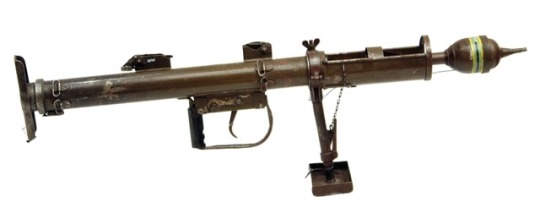

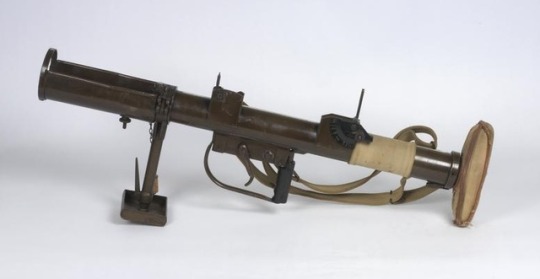
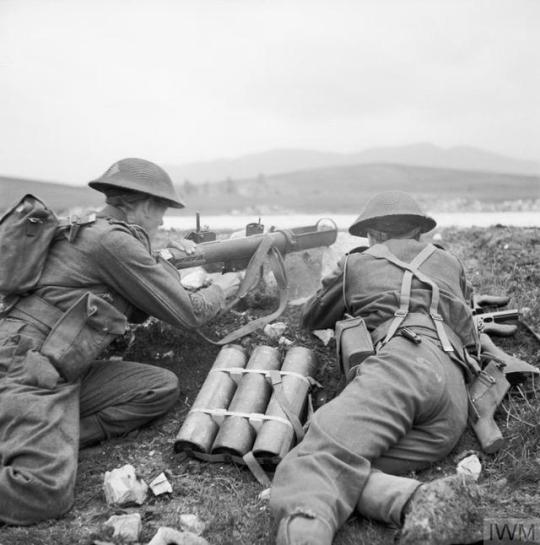
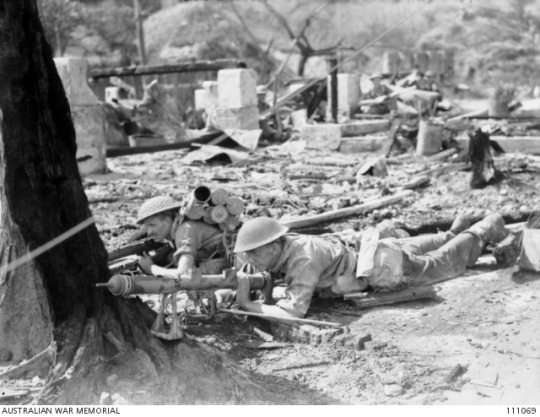
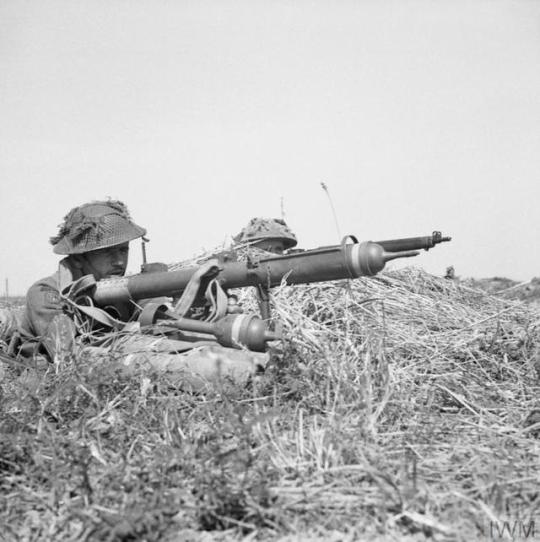
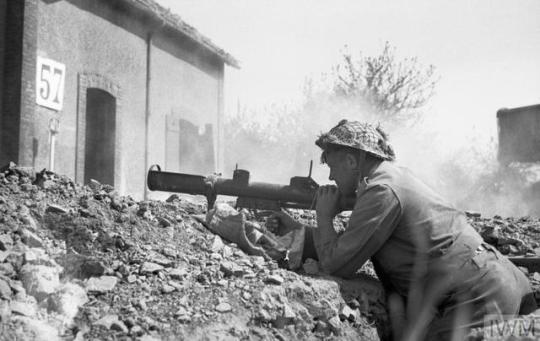
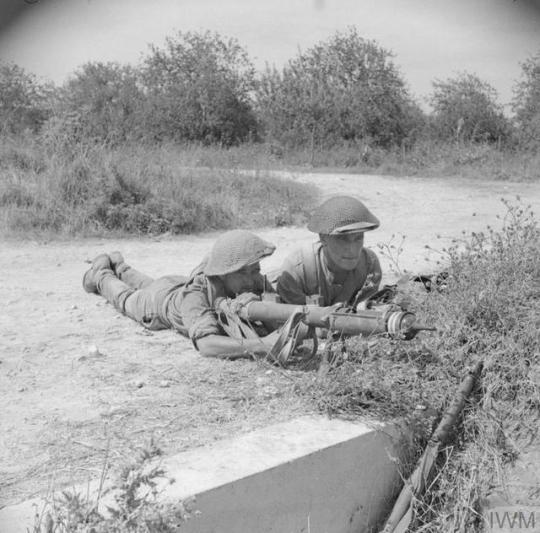
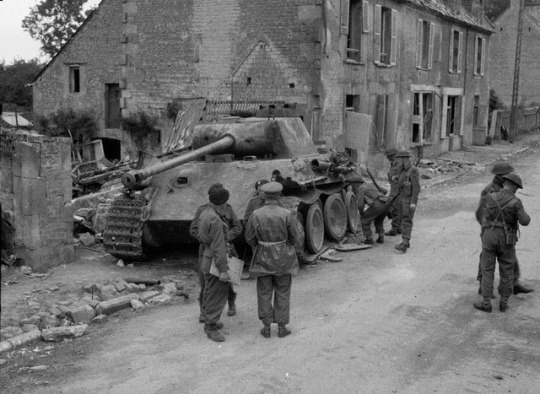
The Projector, Infantry, Anti Tank (PIAT)
In 1941, Britain began developing the Projector, Infantry, Anti Tank, better known as the PIAT. The PIAT would become Britain’s primary anti-tank weapon during World War Two. A year earlier in 1940, the British developed the No. 68 AT Rifle Grenade, however, the No.68 proved unsuccessful and was not widely used. The .55 calibre Boys AT rifle had been in service since 1937, but was quickly found to be ineffective against thicker German armour. The PIAT was a response to the infantry soldier’s need for a lightweight, ranged anti-tank weapon.
Lt-Col. Stewart Blacker took his the 29mm Spigot Mortar, known as the Blacker Bombard, as a basis for a smaller, more portable spigot-based weapon. Blacker developed what he called the ‘Baby Bombard’ - a man-portable, shoulder fired weapon using a hollow charge bomb with a propellant charge in the tail. The Baby Bombard had a large spring and spigot at the base - when the weapon fired the spring was released and the spigot projected up the tail tube of the bomb projecting igniting the propellant charge inside. The ignited propellant charge then forced the bomb off the spigot with propellant gases expanding between the bomb and the spigot throwing it down range. The Baby Bombard was shown to the War Office in June 1941, but initial testing was disappointing. While Blacker moved on to other duties, continuing development was overseen by Major Millis Jefferis, an explosives expert and skilled engineer, at the Ministry of Defence’s research and development establishment MD1. Jefferis redesigned the Baby Bombard, rechristening it the 'Jefferis Shoulder Gun’. It was adopted in the summer of 1942, following successful testing by the Ordnance Board.
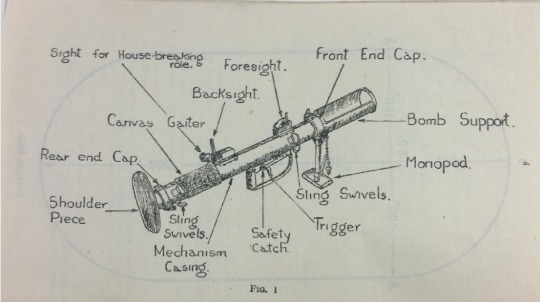
Diagram showing the parts of the PIAT from a 1943 training manual (source)
PIAT production began in August 1942, and it first saw action in the summer of 1943, during the Allied invasion of Sicily and remained in service into the 1950s. Imperial Chemical Industries Ltd. and other manufacturers produced approximately 115,000 by the end of the war.
The weapon itself was 39 inches (1m) long and weighed 32 lbs (15kg). The PIAT was not a rocket launcher, instead it relied on a spring-loaded spigot to detonate a propellant charge and launch a bomb containing a shaped charge.Unlike a rocket launcher the PIAT did not have to withstand high pressures and could be made from sheet steel. the positives of the system included its lack of muzzle flash and relatively little report unlike American Bazookas and German Panzerfausts. It was also relatively cheap to manufacture. However, its main drawbacks were its heavy recoil, problems cocking the weapon and the fragile sheet steel it was made from.
The performance of the PIAT in terms of range and armour penetration was adequate. The 3lb (1.35kg) projectile when fired within 100m could penetrate in excess of 100mm of armour. Optimally the projectile could achieve a muzzle velocity of approximately 450ft/s (137m/s). Although as armour skirts came into use the PIAT became less effective. Its maximum effective range against armour was 115 yards (110m), the PIAT could be used against fixed positions and buildings at up to 350 yards (320m) by arcing projectiles onto the target. It was aimed using an aperture sight and could be stabilised with the weapon’s monopod.
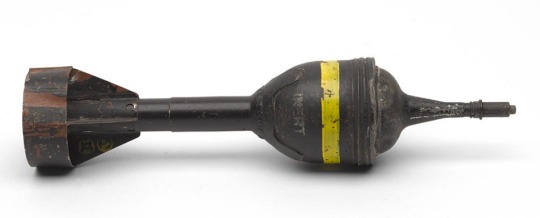
An inert 3lb high explosive PIAT bomb (source)
Each platoon was issued one PIAT, it could be operated by one man but was normally deployed by a two man team, with the second man acting as ammunition carrier and loader. They were extremely useful for airborne units, offering a support weapon able to answer both enemy armour and fixed positions. They were used throughout the war being issued to infantry and also mounted on Universal (Bren Gun) Carriers with mechanised units.
Britain, Canada, Australia and the other Commonwealth nations all used the PIAT. In Australian service it was designated the 'Projector Infantry Tank Attack’ or PITA. The British also dropped PIATs to resistance fighters operating in occupied Europe with many used by the French resistance and some seeing action during the Warsaw Uprising.
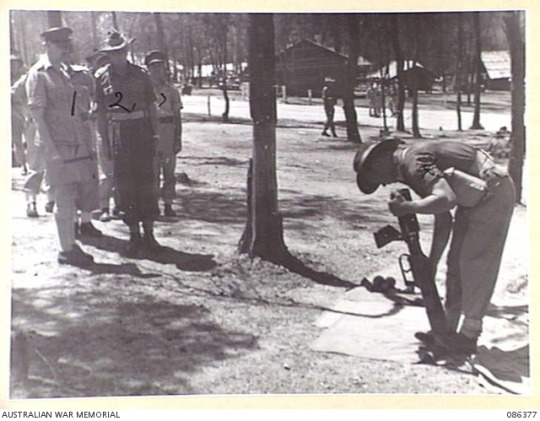
Australian Infantryman demonstrates the loading of a PIAT to Maj. General Milford, c.1945 (source)
Due to their limited range, of about 100 yards, PIATs took a certain amount of courage to use in action. As a result six men were awarded the Victoria Cross for using them to destroy German tanks. During the battle for Arnhem, during Operation Market Garden Major Robert Cain, of 2nd South Staffordshire Regt., won a VC single-handedly immobilising a German Stug Assault Gun and forced three Panzer IVs to retreat using a PIAT. Similarly in Italy in October 1944, Private Ernest Smith used a PIAT to destroy a German Mark V Panther tank winning a VC. 7% of all tanks destroyed by British forces during D-Day operations were knocked out by PIATs, more than destroyed by rocket armed aircraft. Image #7 shows a German Panther tank that was allegedly knocked-out by a PIAT in Bretteville-en-Orguilleuse, near Caen, in summer 1944.
The PIAT needed to be manually cocked before the first shot, theoretically the recoil from firing would then re-cock it for subsequent shots. Cocking was achieved by compressing a large spring within the body of the launcher, this was difficult to achieve without standing up. The PIAT’s manual does depict and explain how this could be accomplished in the prone position.
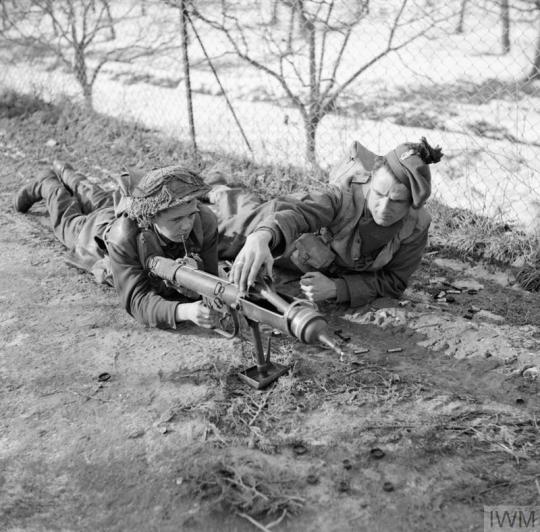
PIAT team from the 1st Btn. London Irish Rifles, the number two loads a projectile (source)
To ready the PIAT to fire the operator would stand the PIAT on its butt, holding it firmly twist the weapon to disconnect the shoulder pad which was attached to the cocking rod. By standing on the shoulder pad and pulling the body of the weapon up the spigot (which acted as a firing pin) and spring were compressed and the spring into the firing position and attached it to the trigger mechanism cocking the weapon. The body was then slid back down to the shoulder pad and re-latched. A projectile was then placed in the in the trough/tray at the front of the weapon. The 'draw weight’ of the PIAT equalled ~90kg of spring tension. The PIAT was difficult to operate by smaller, shorter soldiers. The recoil caused by the detonation of the propellant then blew the spigot/iring pin backwards onto the spring; this automatically cocked the weapon for subsequent shots, theoretically eliminating the need to manually re-cock
While the PIAT was heavy, cumbersome, difficult to cock and hard on the shoulder when fired. It proved an effective anti-tank weapon, capable of defeating most tanks when used with cunning and daring. They later saw action during the Korean War but were phased out of service by the mid-1950s. But were soon replaced by US M20 'Bazooka’ rocket launchers and the No.94 ENERGA AT-Rifle Grenade. The Haganah, the predecessor of the IDF, also used British PIATs during the 1948 Israeli War of Independence.
Sources:
Images: 1 2 3 4 5 6 7 8 9
Projector, Infantry, Anti-Tank, IWM, (source)
PIAT, ParaData, (source)

If you enjoy the content please consider supporting Historical Firearms through Patreon!
#History#Military History#PIAT#Anti tank weapon#Projector Infantry Anti Tank#Ordnance of the Week#British Army#World War Two#Korean War#Spigot Mortar#Blacker Bombard#Baby Bombard#Stewart Blacker#Millis Jefferis#MD1#WWII#WW2#Weapons#Firearms#AT weapons#PITA#Projector Infantry Tank Attack#Bazooka#gunblr#anti tank weapons#anti tank launcher
288 notes
·
View notes
Text
15 Facts About The D-Day Invasion Most People Don’t Know About
var h12precont = 'h12c_300x250_' + Math.floor(Math.random()*1000000); document.write('
'); (h12_adarray = window.h12_adarray || []).push({"adcontainer":h12precont,"placement":"c9d6b99f00114c5a436a0f497c7bb182","size":"300x250","type":"standard","width":"300","height":"250","name":""});
On June 6, 1944, the D-Day invasion by Allied forces started within the French area of Normandy. What occurred on D-Day, one of many largest army undertakings in world historical past, stays among the many most outstanding tales of WWII. Details about this endeavor, code named Operation Overlord, proceed to amaze the general public over 70 years after this momentous occasion. Listed below are some outstanding and shocking particulars concerning the D-Day invasion, the assault that was the start of the tip of the Nazi Reich and floor zero for the onset of the battle for the liberation of Europe. From main males you had no concept landed on D-Day to sleeping Nazi management, the invasion that started the tip of WWII is stuffed with shocking, heroic, and heart-wrenching moments.
The Allies Have been Drastically Helped By Hitler Sleeping In
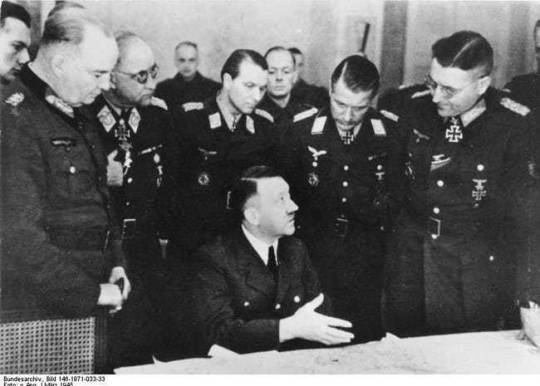
By mid-1944, Adolf Hitler’s physician was treating him with medicines that included amphetamines and possibly even cocaine. Consequently, Hitler would stay awake into the wee early morning hours and sleep till the early afternoon. Even essentially the most superior members of the German excessive command had been conscious of this conduct and knew that he would turn out to be angry if disturbed. Hitler had additionally forbidden commanders within the area from adjusting troop positions with out his particular permission. When a number of generals within the Normandy space needed to instantly deploy two German panzer divisions to assault the tenuous Allied toehold as shortly as doable, they needed to wait until late morning earlier than disturbing Hitler. By that point, the clouds stopping Allied air assaults had damaged, and Nazi reinforcements might solely proceed by evening, significantly decreasing German means to counterattack and guaranteeing the success of the touchdown.
The Climate Forecast Performed A Decisive Function In D-Day’s Success
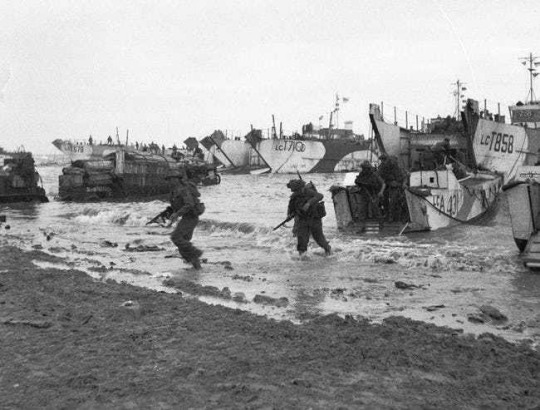
As a result of D-Day relied so closely on points surrounding climate, tides, cloud cowl, and moonlight, solely sure days might be thought-about for the invasion. Initially, Allied meteorologists chosen June 5, 1944, as essentially the most advantageous day for the assault. Nonetheless, tough seas, excessive waves, and excessive cloud cowl might be sufficient on their very own to make sure the failure of the operation. On June 4, British army meteorologist James Stagg overruled his employees and really useful a postponement of the invasion till June 6. He believed {that a} 12-hour window would open that will enable for the invasion to proceed however was sure that June 5 could be a catastrophe. Different forecasters believed that the invasion ought to be postponed till a date two weeks later within the hopes that the climate would possibly enhance. In 1944, there have been not one of the climate satellites or expertise that exist right this moment, solely anecdotal proof gathered from varied vantage factors within the British Isles and the Atlantic.
The last word resolution could be made by Common Eisenhower, Supreme Commander of the Allied forces. He gambled on the 12-hour window and hoped that Stagg was right. Whereas June 6 was not good, the invasion was capable of proceed, and a window of barely higher climate prevented the local weather from being an element within the invasion. Sadly for the Germans, their chief Luftwaffe meteorologist didn’t have entry to Stagg’s wealth of knowledge, and his forecast was for persistently dangerous climate that will forestall an invasion for at the least a number of weeks. The German excessive command operated underneath this notion, one of many causes that they had been caught off guard when the invasion started.
Erwin Rommel Was At Dwelling In Germany, Celebrating His Spouse’s Birthday

One of many people who might need performed a serious position in efficiently repelling the Allied invasion was Discipline Marshall Erwin Rommel. An excellent tactician nicknamed “The Desert Fox” for his exploits through the Nazi marketing campaign in North Africa, Rommel was reassigned to oversee the protection of the “Atlantic Wall,” the protection system applied by Germany to defend towards any invasion. Rommel had spent many of the earlier 5 years away from his spouse and son and needed to briefly return house to have a good time his spouse’s 50th birthday. He even bought a pair of footwear in Paris for the event. When his employees, based mostly on optimistically incorrect climate reviews, assured him that the Allies couldn’t probably assault anyplace on the French coast, he took the chance to return to Germany. Different senior officers had been ordered to take part in a struggle recreation train that additionally took them away from the rapid area of battle. Knowledgeable of the assault in the early morning of June 6, Rommel rushed again to the entrance and managed to reach that night. By then, the Allies had secured the beachhead at Normandy, and Rommel was powerless to cease the invasion.
Secret Code Phrases From The Invasion Mysteriously Appeared In A Crossword Puzzle In Advance

In Might of 1944, a member of Britain’s intelligence service, MI5, was observant sufficient to identify the reply “Utah” in a crossword puzzle in a big circulation London newspaper, The Day by day Telegraph. Initially dismissed as a coincidence, brokers had been shocked when, inside a number of weeks and solely days earlier than the deliberate D-Day invasion, the phrases Omaha, Overlord, Mulberry, and Neptune all appeared as solutions in the identical Day by day Telegraph crossword. All of those names had been secret phrases carefully related to the upcoming invasion. Safety companies shortly hauled within the composer of the crossword puzzles, Leonard Dawe, who turned out to be a headmaster at an area non-public college, The Strand College. Regardless of an intense interrogation that Dawe refused to explain till many years later, finally MI5 was glad that he was not an enemy agent.
However the thriller of how the phrases wound up within the puzzles remained. In 1984, one among Dawe’s college students on the time, Ronald French, wrote to the paper to elucidate that the headmaster would have his courses give him random phrases that he would then embrace in his puzzles. As a result of the scholars routinely socialized and had been uncovered to servicemen of their neighborhoods, they naturally picked up on a few of the phrases that these troopers repeatedly used. French thought it could be intelligent to incorporate these phrases within the crossword and gave them to the unwitting headmaster. After his interrogation, Dawe supposedly confronted French, who admitted what he had achieved. Sadly, by the point French contacted the Telegraph, Dawe was lengthy gone, and lots of are nonetheless skeptical of this rationalization for the outstanding D-Day crossword puzzle coincidence.
Ted Roosevelt Jr. Was The Solely Common In The Preliminary Wave

Theodore Roosevelt Jr., son of President Roosevelt, was initially instructed that, due to a coronary heart situation and arthritis, he wouldn’t take part within the precise D-Day invasion. Roosevelt – armed with solely a pistol and a cane – insisted and got here ashore with the primary wave of troops at Utah Seaside, the one basic to take action. Touchdown a mile away from his meant location, Roosevelt improvised a route inland after personally reconnoitering the realm behind the seashore. He would stay on the seashore for the remainder of the day, directing subsequent waves of troops to their improvised areas. Ignoring bullets and explosions that occurred in his neighborhood, Roosevelt remained a relaxing affect on the apprehensive troopers who got here ashore. Requested later to single out essentially the most heroic act he noticed throughout his profession, Common Omar Bradley responded: “Ted Roosevelt at Utah Seaside.” Ted Roosevelt Jr. died of a coronary heart assault one month after D-Day, was posthumously awarded the Medal of Honor, and is buried within the American cemetery close to the Normandy beachhead
Two Medics Risked Their Lives To Heroically Present Care

One of many lesser recognized tales of D-Day entails two American medics who offered help to each Allied and German troopers who had been introduced into their tiny church sanctuary. Robert Wright and Kenneth Moore had been parachuted behind German traces within the early hours of the D-Day invasion. Touchdown with different paratroopers close to Utah Seaside, their unit’s goal was a highway junction close to the French hamlet of Angoville-Au-Plain. Wright and Moore chosen essentially the most logical close by construction to arrange their medic station, the village church. For 3 days, they tended to many wounded – together with French civilians and even Germans – injured within the fierce preventing across the church. German panzer counterattacks finally pushed American troops away from Angoville-Au-Plain, however the medics determined to remain and proceed to take care of the numerous troopers counting on them. A number of occasions, German SS personnel angrily entered the church, intent on capturing the wounded Individuals inside however left when confronted with Wright and Moore additionally tending to significantly injured German troopers. Finally, a Purple Cross banner was positioned in entrance of the constructing, indicating to each side that the makeshift hospital ought to be left alone. Even so, there have been many anxious moments for Wright and Moore, together with an unexploded mortar shell that landed within the heart of the church and didn’t explode. One of many medics shortly picked up the projectile, ran exterior, and tossed it right into a area, regardless of the potential for the shell detonating at any second.
Halfway by means of the ordeal, two German snipers who had been hidden within the steeple, realized that they had been drawing hearth to the church and surrendered to the astonished Wright and Moore. On June 8, the Germans had been safely pushed out of the realm, the medics having saved over 80 lives within the interim. Finally, the destroyed stained glass home windows had been changed with memorials to each the 101st Airborne and the medics themselves. The pews of the church stay bloodstained, and the cracked ground sq. the place the mortar shell landed remains to be seen. Kenneth Moore and Robert Wright had been each awarded the Silver Star. When he died, the townspeople of Angoville-Au-Plain honored Wright’s request and buried him within the church graveyard.
Confronted With The Not possible, Rangers At Pointe-Du-Hoc Have been The First to Full Their Mission On D-Day
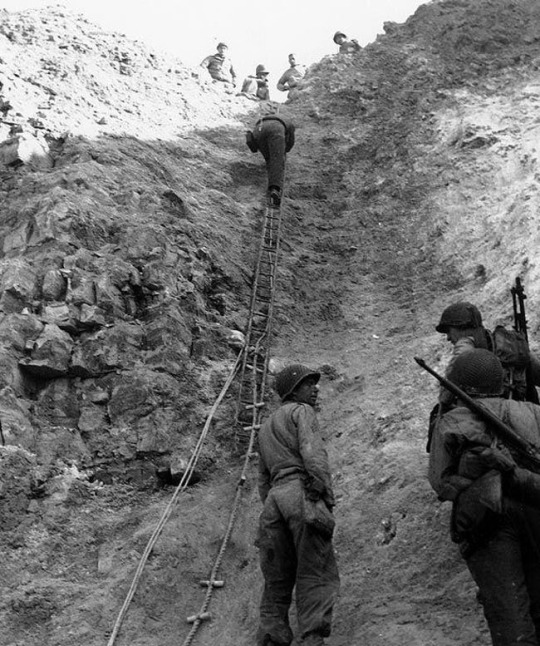
One of many hardest targets handed out on D-Day was the mission to knock out the German 155mm batteries on the promontory of Pointe-Du-Hoc. American airborne Rangers could be given the duty of scaling the cliff-side location virtually 100 ft right into a nest of closely fortified bunkers and pillboxes defending the German artillery, which was a risk to each the lads on the seashores and the ships at sea. Solely half of the designated Ranger assault power reached the bottom of the cliffs. Late and disorganized, they had been by no means capable of sign the secondary group, which was then diverted to Omaha Seaside, probably saving that effort. Regardless of the lack of manpower, the Rangers started the method of ascending the seawall, accompanied by artillery shelling from Allied destroyers that offered cowl. The Rangers shortly obtained to the highest, subdued or repelled any defenders, and had been shocked to seek out that the gun emplacements contained solely phone poles, positioned there to idiot Allied reconnaissance.
Thankfully, tire tracks result in the brand new German artillery place, and the Rangers shortly disabled the 155mm weapons with grenades. By 9 am, they had been capable of sign that that they had reached their goal, the primary Allied unit to efficiently full their mission. Sadly, the Germans would furiously counterattack for the following two days, the Rangers remoted and unable to be resupplied from the water and trapped towards the cliffs by German models. The one reinforcements had been three American paratroopers who landed off track and by some means made it by means of German traces to the Rangers’ place. The Rangers would maintain their place till the morning of June 8, when different Ranger models and armored infantry drove the Germans from the neighborhood. By then, two thirds of the preliminary Ranger group that had climbed the cliffs had both been captured, wounded, or killed.
Omaha Seaside May Have Been Worse

All through 1944, a philosophical battle came about between Common Rommel and different members of the German basic employees. Rommel firmly believed that the Allies ought to be prevented from touchdown and establishing a beachhead anyplace on the coast of France. Different officers believed that troops ought to be held in reserve and shortly rushed in to counterattack and wipe out any invasion. Regardless of Rommel’s particular orders to the 352nd Infantry Division to maneuver its 5 artillery and 10 infantry battalions of the division to the neighborhood of the Omaha beachhead, Rommel’s subordinates ignored these commands and positioned all however two infantry and one artillery battalions in reserve, extra in step with German excessive command technique. Whereas the Omaha Seaside touchdown was essentially the most tough and dear of the 5 invasion factors, it might have been a lot worse – and might need even jeopardized your complete invasion – had your complete German functionality at Omaha Seaside been utilized to stop a linkup of the Allies within the early days of the invasion.
The Theater Of Battle Was 50 Miles Vast
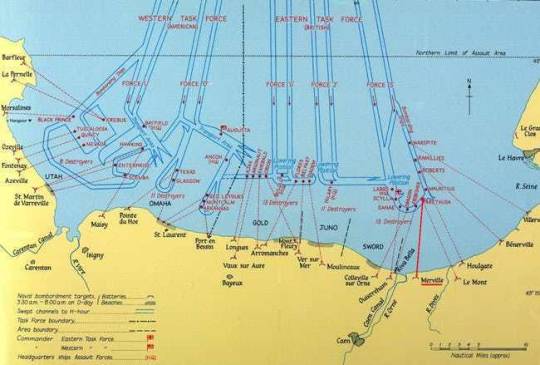
Subsequent movies and dramatizations of D-Day are typically restricted in portraying the scope of the scale of the D-Day invasion. A lot of the main focus of movies like Saving Personal Ryan is a small stretch of seashore and a small variety of people engaged in their very own private battle. However D-Day concerned an assault that consisted of near 75,000 infantry, paratroopers, and assist personnel that will land on or behind 5 separate seashore areas designated by the Allies. These designated websites had been code named “Juno,” “Sword,” “Gold,” “Omaha,” and “Utah.” The seashores comprised an space that stretched for over 50 miles.
A Gown Rehearsal For D-Day Was A Full Catastrophe
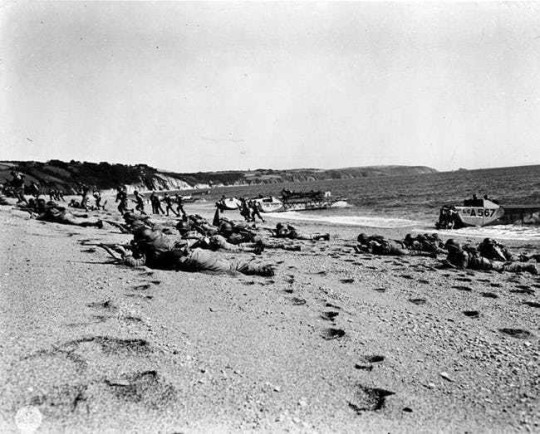
5 weeks earlier than D-Day, on April 28, 1944, an Allied group of ships and amphibious autos had been shifting slowly within the English Channel to arrange for his or her participation in “Exercise Tiger,” a dry run of the amphibious effort that will represent a big a part of the deliberate D-Day invasion. When an enormous improve in radio visitors tipped off German naval property within the neighborhood that one thing main was occurring, Nazi torpedo patrol boats had been dispatched to the realm with deadly outcomes. They started torpedoing the amphibious LST touchdown craft that had been jammed with American troopers, forcing survivors of the assault to desert ship, many with improperly applied life vests that every one however ensured drowning. In all, 749 individuals within the fiasco died, the most costly coaching train of the struggle. The catastrophe was coated up by the army, to attenuate lack of morale and keep away from additional tipping off the Germans to the upcoming invation. Moreover, each Dwight D. Eisenhower and Winston Churchill had been so involved by this failure that that they had grave doubts about D-Day itself.
Ike Returned To The D-Day Battlefield Solely As soon as

President Eisenhower visited the American cemetery and the D-Day battlefield solely as soon as after World Conflict II. This was not the results of indifference; quite, it was Ike’s inability to control his emotions when publicly talking concerning the sacrifice and braveness of the lads he despatched to Normandy and the heroes who by no means returned. In contrast to subsequent Presidents, who used D-Day as a photo-op, Eisenhower additionally didn’t need to be perceived as aggrandizing himself on the expense of the rank and file troopers who unselfishly gave their lives throughout battle. Nonetheless, after his Presidency, Eisenhower returned to the D-Day battlefield and the American cemetery at Colleville-Sur-Mer to commemorate the 20th anniversary of the invasion.
Atrocities Have been Widespread On Each Sides On D-Day
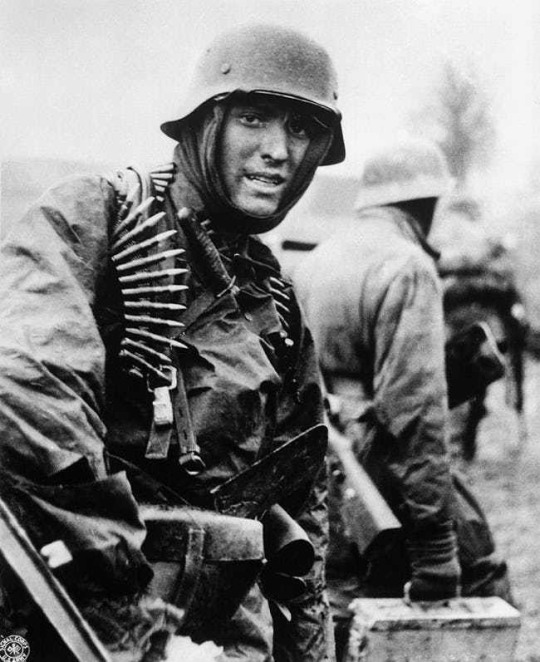
D-Day was the right storm to brew the horrors of war and brutal war crimes that had been dedicated by each Allied and Nazi troops. Most of the German models deployed in Normandy had been battle-hardened Waffen-SS with expertise on the Jap Entrance, the place POWs and civilians had been routinely and methodically executed. Canadian troops had been additionally embittered by their fellow countrymen’s expertise on the failed 1942 commando raid at Dieppe, through which Canadian prisoners had been subsequently murdered by their German captors.
These attitudes, mixed with the chaos of a frantic and complicated army state of affairs, didn’t bode nicely for the organized and humane remedy of prisoners. Nearly 200 Canadian prisoners had been executed within the first two days of the D-Day invasion, their continuously mutilated our bodies often retrieved en masse leaving little question as to how they died, a improvement that solely enraged Allied troops and perpetuated the violence. SS troops, infamous for his or her cruelty, had been hardly ever discovered to have been taken prisoner, continuously formally shot “whereas attempting to flee.” German snipers particularly focused troopers carrying a Purple Cross armband, understanding that they had been offering help to already wounded and probably dying troopers. These had been simply a few of the callous attitudes that contributed to the virtually 500,000 troopers killed on each side through the D-Day invasion.
D-Day Was Adopted By A Two-Month Stalemate
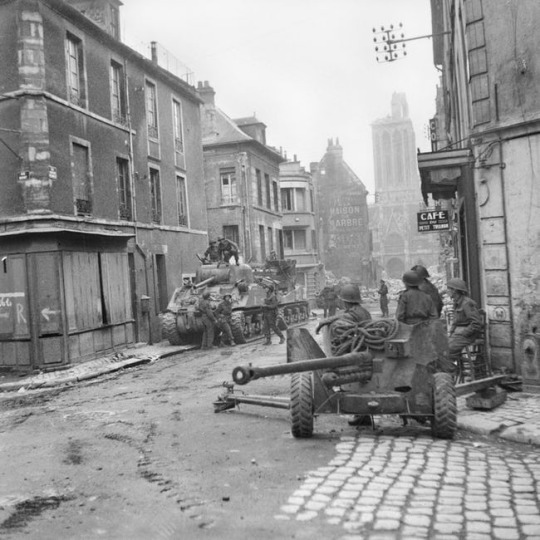
Regardless of the preliminary success, the D-Day invasion would not result in a rapid consolidation and an instantly profitable sweep throughout France. Allied troops would lavatory down within the swampy and intentionally flooded space on the Normandy peninsula. The normal tall hedgerows that farmers in Normandy used to frame their farmlands additionally proved to be an ideal vantage level for German defenders and an impediment for Allied tanks. City areas additionally needed to be captured and neutralized on a house-by-house foundation, a pricey and well timed course of. Most of the models going through the Allies had been SS models, essentially the most fanatical within the German army. It will not be till mid-August that Allied forces would start to overwhelm cussed resistance and power a German retreat behind the Seine River. Inside months, Allied forces recaptured most of France and had been poised to enter Germany itself.
Star Trek’s Unique “Scotty” Was Wounded on D-Day

On June 6, a Canadian named James Doohan got here ashore on Juno Seaside as a member of the third Canadian Infantry Division. Doohan was capable of survive the preliminary assault, however, after dusk, he was unintentionally shot six occasions by one other Canadian sentry. Thankfully, one of many bullets hit a cigarette case, which stopped it from going into his chest, however one other hit him within the hand, forcing the amputation of a finger. The remaining 4 went into his leg.
After the struggle, Doohan used his distinctive voice for appearing and radio work and finally grew to become a continuously forged character actor on Canadian and American tv. He would finally get hold of the position of Montgomery “Scotty” Scott on the TV present Star Trek, his versatility with accents permitting him to face out and to carry depth to the position. He all the time hid his lacking finger throughout taping, most viewers unaware of the heroic background of the person who made the phrase “Beam me up, Scotty,” the watchwords of a technology.
Associated
Artykuł 15 Facts About The D-Day Invasion Most People Don’t Know About pochodzi z serwisu PENSE LOL.
source https://pense.lol/15-facts-about-the-d-day-invasion-most-people-dont-know-about/
0 notes
Text

• Battle of Kasserine Pass
The Battle of Kasserine Pass was a series of battles of the Tunisia Campaign of World War II that took place in February 1943. Covering Kasserine Pass, a 2-mile-wide (3.2 km) gap in the Grand Dorsal chain of the Atlas Mountains in west central Tunisia.
U.S. and British forces landed at several points along the coast of French Morocco and Algeria on November 8th, 1942, during Operation Torch. This came only days after the breakthrough of the British Eighth Army (Lieutenant-General Bernard Montgomery) following the Second Battle of El Alamein. In response, German and Italian troops were ferried in from Sicily to occupy Tunisia, one of the few easily defended areas of North Africa and only one night's sail from bases in Sicily. The Run for Tunis in November and December 1942 is the term for an attempt to reach Tunis before German and Italian reinforcements could arrive. Because of the poor road and rail communications, only a small, division-sized Allied force could be supplied, and, due to the excellent defensive terrain, small numbers of German and Italian troops were sufficient to defeat the attempt. The Allied build-up continued, more aircraft became available and new airfields in eastern Algeria and Tunisia were built. The Allies reduced the flow of Axis troops and equipment into Tunis and Bizerta, but a sizable Axis force was already ashore.
Allied troops had already crossed the Atlas Mountains and set up a forward base at Faïd, in the foothills on the eastern arm of the mountains, an excellent position to thrust east to the coast, split the Axis forces in southern Tunisia from the forces further north, and cut the line of supply to Tunis. Elements of the 5th Panzer Army, headed by General Hans-Jürgen von Arnim, reached the Allied positions on the eastern foot of the Atlas Mountains on January 30th. The 21st Panzer Division met French troops at Faïd, and, despite excellent use of the French 75 mm (2.95 in) guns, which caused heavy casualties among the German infantry, the defenders were easily forced back. U.S. artillery and tanks of the 1st Armored Division then entered the battle, destroying some enemy tanks and forcing the remainder into what appeared to be a headlong retreat. This was, however, a trap, and when the 1st Armored Division gave chase it was engaged by a screen of German anti-tank guns, and sustained heavy casualties. The 21st Panzer Division resumed its advance towards Faïd. Several attempts were made by the 1st Armored Division to stop the German advance, but all three combat commands found that each defensive position they tried to occupy had already been overrun, and they were attacked by German troops with heavy losses. The Allies held the interior of the roughly triangular Atlas range, but with the exits blocked this was of little advantage to the Allies. For the next two weeks, Rommel and the Axis commanders further north debated what to do next.
Rommel did not consider the Eighth Army a serious threat because, until Tripoli was open, Montgomery could maintain only a small force in south Tunisia. Ships commenced unloading on February 9th, but the port was not fully operational until the end of the month. On February 14th, the 10th and 21st Panzer divisions began the Battle of Sidi Bou Zid, about 10 mi (16 km) west of Faïd, in the interior plain of the Atlas Mountains. The U.S. tanks were defeated and the infantry, poorly sited on three hills and unable to give mutual support, was isolated. A counterattack the next day was easily repulsed and on February 16th, the Germans advanced towards Sbeitla. After several further withdrawals the U.S. II Corps was able to concentrate at the Kasserine and Sbiba Passes, on the western arm of the mountains. U.S. casualties were 2,546 men, 103 tanks, 280 vehicles, 18 field guns, three anti-tank guns.
At this point, there was some argument in the Axis camp about what to do next; all of Tunisia was under Axis control, and there was little to do until the Eighth Army arrived at Mareth. Rommel decided to attack through the Kasserine Pass into the main force of the U.S. II Corps at Tébessa to capture U.S. supplies on the Algerian side of the western arm of the mountains, eliminate the Allied ability to attack the coastal corridor linking Mareth and Tunis and threaten the southern flank of the First Army. On February 18th, Rommel submitted his proposals to Albert Kesselring, who forwarded them with his blessing. In the early hours of February 19th, Rommel ordered the Afrika Korps Assault Group from Feriana to attack the Kasserine Pass. The 21st Panzer Division at Sbeitla was ordered to attack northward through the pass east of Kasserine which led to Sbiba and Ksour. The Kampfgruppe von Broich, the battlegroup released by Arnim from 10th Panzer Division, was ordered to concentrate at Sbeitla, where it would be ready to exploit success in either pass.
The Sbiba area was attacked by Battle Groups Stenkhoff and Schuette, remnants of the 21st Panzer Division. Facing the German armored advance was the British 6th Armoured Division (less the 26th Armoured Brigade which except for the tanks of the 16/5th Lancers had been sent to Thala). Also in the line was the 18th Regimental Combat Team from the U.S. 1st Infantry Division; and three battalions of infantry from U.S. 34th Infantry Division. There were also three U.S. Field Artillery battalions, elements of two British anti-tank regiments and some French detachments. The Germans made little progress against the combined firepower of the defending force which had also laid minefields.
Defending the pass was a force consisting of the U.S. 1st Battalion, 26th Regimental Combat Team, the U.S. 19th Combat Engineer Regiment, the 6th Field Artillery Battalion, a tank destroyer battalion and a battery of French artillery. On the hills to their west was French General Welvert's Task Force Welvert comprising a U.S. Ranger and infantry battalion, three French infantry battalions, two U.S. field artillery battalions, four French artillery batteries and engineer and anti-aircraft detachments. Furthest west was Task Force Bowen (consisting of the 3rd Battalion of the 26th Regimental Combat Team), blocking the track from Feriana towards Tebessa. An attempt to surprise the Kasserine defenses by the 33rd Reconnaissance Unit into the pass failed and a battalion of Panzer grenadiers was ordered into the floor of the pass and another onto Djebel Semmama, the hill on its eastern flank and slow progress was made against artillery fire. The tanks of 8th Panzer Regiment were committed at noon but little further progress resulted against stubborn defense. Rommel decided to commit his units from the 10th Panzer to the Kasserine Pass the next morning in a coordinated attack with the Afrika Korps Assault Group, which was to be joined by elements of the Italian 131st Armored Division Centauro.
During the night, the American positions on the two shoulders overlooking the pass were overrun and at 8:30 am German panzer grenadiers and Italian Bersaglieri resumed the attack. At 10:00am Brigadier Dunphie judged that Colonel Alexander Stark's force was about to give way and ordered Gore Force to the Thala side of the pass as elements of the Centauro Division launched their attack towards Tebessa and continued it during the afternoon. At 1:00 pm Rommel committed two battalions from 10th Panzer which overcame the defense. Tanks and Bersaglieri from the Centauro Division advanced along Highway 13 and overran the 19th Combat Engineer Regiment. The U.S. survivors made a disorganized retreat up the western exit from the pass to Djebel el Hamra, where Combat Command B of the 1st Armored Division was arriving.
The Afrika Korps Assault Group began moving along the Hatab River valley towards Haidra and Tebessa in the early afternoon of February 21 and advanced until they met defenders consisting of the U.S. 16th Infantry Regiment, 1st Infantry Division and Combat Command B of the U.S. 1st Armored Division at Djebel el Hamra. The German–Italian force was halted and, despite heavy pressure including air attacks, failed to dislodge the American defenders. Having brought the Axis drive towards Tebessa to a halt, General Paul Robinett and General Terry Allen now turned their attention to planning a counterattack that was to take place the next day, February 22nd. Plans made by both sides were upset by the battle, and the Axis forces (5 Bersaglieri, a Semovente group from Centauro and 15 Panzer) launched another assault on the U.S. position on the morning of the 22nd. Although the American defenders were pressed hard the line held and, by mid-afternoon, the U.S. infantry and tanks launched a counterattack that broke the combined German and Italian force. More than 400 Axis prisoners were taken as the counterattack was pressed into the Afrika Korps position.
Overextended and with supplies dwindling, pinned down by the Allied artillery in the pass in front of Thala and now facing U.S. counterattacks along the Hatab River, Rommel realized his attack had been stopped. At Sbiba, along the Hatab River and now at Thala, the efforts of the German and Italian forces had failed to make a decisive break in the Allied line. With little prospect of further success, Rommel judged that it would be wiser to break off to concentrate in South Tunisia and strike a blow at the Eighth Army, catching them off balance while still assembling its forces. At a meeting at Rommel's Kasserine HQ on February 23rd Kesselring and his Chief of Staff Siegfried Westphal tried to change Rommel's mind, arguing that there were still possibilities for success. Rommel was adamant; Kesselring finally agreed and formal orders were issued that evening calling off the offensive and directing all Axis units to return to their start positions. On the 23rd, a massive American air attack on the pass hastened the German retreat and by late on February 24th, the pass had been reoccupied, Feriana was in Allied hands; Sidi Bou Zid and Sbeitla followed soon after.
German losses at Kasserine were 201 killed, 536 wounded and 252 missing, totalling 989 casualties. In material Germans lost 20 tanks, 67 vehicles and 14 guns. Allied forces captured 73 German and 535 Italian soldiers. American losses totalled 300 killed, 3,000 wounded, and 3,000 missing. Losses were so high that an additional 7,000 replacements were needed to recover units to their original strength. The French losses on the 34th Division totalled 50 killed, 200 wounded and 250 missing. Material losses of the US II Corps were staggering, in total 183 tanks, 104 half tracks, 208 guns and 512 trucks and motor vehicles were lost, some of them captured by the Germans. The allies also lost supplies and fuel, over 215 cubic meters of gasoline and lubricants were seized. Rommel had hoped to take advantage of the inexperience of the new Allied commanders but was opposed by Arnim who, wanting to conserve strength in his sector, ignored Kesselring's orders and withheld the attached heavy tank unit of 10th Panzer. Rommel felt that most U.S. units and commanders had showed their inexperience, losing sight of the broader picture. Rommel was later impressed with how quickly U.S. commanders came to understand and implement mobile warfare and also praised U.S. equipment: "British experience has been put to good use in American equipment". The Allies studied the results equally seriously. Positioned by senior commanders who had not personally reconnoitered the ground, U.S. forces were often located too far from each other for mutual support. It was also noted that U.S. soldiers tended to become careless about digging in, exposing their positions, bunching in groups when in open view of enemy artillery observers.
#second world war#world war 2#world war ii#north africa#tunisia#german history#american history#afrika corp#erwin rommel#military history
101 notes
·
View notes
Photo

Nicholas Oresko was born on January 18, 1917. He was an American combat veteran of World War II who received the Medal of Honor for his valorous actions in Germany on January 23, 1945.
Oresko was born in Bayonne, New Jersey. He was the descendant of Ukrainian people.
He joined the US Army in March 1942. He was sent to Europe and arrived in France in September 1944, three months after the Normandy landings. A platoon sergeant in Company C, 1st Battalion, 302nd Infantry Regiment, 94th Infantry Division, he spent the next several months with his unit mopping up pockets of German soldiers who had been bypassed in the Allies' initial push through the northern part of France. In December 1944, the 93th Division was redeployed to replace the 90th Infantry Division as part of General Patton's Third Army. The 95th Division assumed positions opposite the Westwall and the German's 11th Panzer Division.
On January 23, 1945, near Tettingen, Germany, Master Sergeant Oresko single-handedly and under enemy fire, took out a German bunker position that was armed with a machine gun. Seriously wounded by another enemy machine gun from another bunker, he attacked that bunker under fire and destroyed that enemy position. Nine months later on October 30, 1945, he was awarded the Medal of Honor. President Harry Truman formally presented Oresko the medal during a ceremony at the White House.
Medal of Honor citation
Master Sergeant Oresko's official Medal of Honor citation reads:
M/Sgt. Oresko was a platoon leader with Company C, in an attack against strong enemy positions. Deadly automatic fire from the flanks pinned down his unit. Realizing that a machinegun in a nearby bunker must be eliminated, he swiftly worked ahead alone, braving bullets which struck about him, until close enough to throw a grenade into the German position. He rushed the bunker and, with pointblank rifle fire, killed all the hostile occupants who survived the grenade blast. Another machinegun opened up on him, knocking him down and seriously wounding him in the hip. Refusing to withdraw from the battle, he placed himself at the head of his platoon to continue the assault. As withering machinegun and rifle fire swept the area, he struck out alone in advance of his men to a second bunker. With a grenade, he crippled the dug-in machinegun defending this position and then wiped out the troops manning it with his rifle, completing his second self-imposed, 1-man attack. Although weak from loss of blood, he refused to be evacuated until assured the mission was successfully accomplished. Through quick thinking, indomitable courage, and unswerving devotion to the attack in the face of bitter resistance and while wounded, M/Sgt. Oresko killed 12 Germans, prevented a delay in the assault, and made it possible for Company C to obtain its objective with minimum casualties.
Oresko died while undergoing surgery for a broken femur on October 4, 2013. He was 96 years old.
Daily inspiration. Discover more photos at http://justforbooks.tumblr.com
12 notes
·
View notes
Text
Historical World War 2 Games
Started out as a content warning list but needed to become its own list because of the sheer size of it.
This is still a WIP and all suggestions and corrections are encouraged.
101: The Airborne Invasion of Normandy
1939
1941: Counter Attack
1941: Frozen Front
1942: Joint Strike
1942: Pacific Airwar Franchise
1943: Kai
1943: The Battle of Midway
1944: The Loop Master
1945: Airwar
1945 I & II: The Arcade Games
‘43 - One Year After
50 Mission Crush
Ace of Aces
Aces of the Deep Franchise
Aces of the Pacific Franchise
Aces of War
Aces over Europe
Achtung Panzer: Kharkov 1943
Achtung Spitfire
Achtung Panzer: Operation Star
Across the Rhein
Action in The North Atlantic
Action Stations!
Admiral Graf Spee
Advanced Destroyer Simulator
African Desert Campaign
Afrika Korps
Airborne Assault Franchise
Airborne Hero D–Day Frontline 1944
Air Conflicts: Aces of World War
Air Conflicts: Air Battles of World War
Air Conflicts: Pacific Carriers
Air Conflicts: Secret Wars
Air Duel: 80 Years of Dogfighting
Airfix: Dogfighter
Air Legends
Air Raid: This is Not a Drill
Allied General
Anglo-German War 39-45
Ardennes Offensive
Ardeny
Ardeny 1944
Armageddon Squadron
Arnhem: The 'Market Garden’ Operation
Artillery Brigade
Assault Wings 1944
Atlantic Patrol
Attack on Pearl Harbour
At the Gates of Moscow 1941
Avalanche: The Struggle for Italy
Avalon Hill’s Squad Leader
Axis & Allies Franchise
B-17 Franchise
B-24
Battle Academy Franchise
Battlefield 1942 Franchise
Battlecruiser
Battle for Midway
Battle for Normandy
Battlefront
Battleground 1: Bulge - Ardennes
Battleground: Ardennes
Battle Group
Battlehawks 1942
Battle Islands
Battle of Britain (1982)
Battle of Britain (1985)
Battle of Britain (1999)
Battle of Britain: 303 Squadron
Battle of Britain II: Wings of Victory
Battle of Britain: Memorial Flight
Battle of Europe
Battle of the Bulge
The Battle of the Bulge: Tigers in the Snow
Battleship 88: Iron Hero
Battles in Normandy
Battlestations: Midway
Battlestations: Pacific
Battlestrike: Force of Resistance
Battlestrike: The Road to Berlin
Battlestrike: The Siege
BBC Battlefield Academy
Beyond Normandy: Assignment: Berlin
Beyond Pearl Harbor: Pacific Warriors
The Big Three
Birds of Steel
Bismarck
Bismarck: Death of a Battleship
Blazing Angels
Blazing Angels 2: Secret Missions of WWII
Blitzkrieg Franchise
Bomb Alley
Breakthrough in the Ardennes
Brothers in Arms Franchise
The Bulge: Battle for Antwerp
Call of Duty
Call of Duty 2
Call of Duty 3
Call of Duty: Finest Hour
Call of Duty: Legacy
Call of Duty: Road to Victory
Call of Duty: United Offensive
Call of Duty: World at War
Call to Arms
Campaign
Cannon Strike
Carrier Strike: South Pacific 1942-44
Carrier Aces
Carrier Force
Carriers at War
Chain of Command
Chain Of Command: Eastern Front
Clash of Steel: World War II, Europe 1939-45
Close Assault
Close Combat: A Bridge Too Far
Close Combat: Cross of Iron
Close Combat: Gateway to Caen
Close Combat III: The Russian Front
Close Combat: Invasion: Normandy - Utah Beach to Cherbourg
Close Combat: Last Stand Arnhem
Close Combat: Panthers in the Fog
Close Combat: The Battle of the Bulge
Close Combat: The Longest Day
Close Combat: Wacht am Rhein
Codename: Panzers Franchise
Combat Command
Combat Command 2: Danger Forward
Combat Mission: Beyond Overlord
Combat Mission 3 - Afrika Corps
Combat Elite: WWII Paratroopers
Commandos: Behind Enemy Lines
Commandos: Strike Force
Commandos 2: Men of Courage
Commandos 3: Destination Berlin
Company of Heroes
Company of Heroes: Opposing Fronts
Company of Heroes: Tales of Valor
Company of Heroes 2
Company of Heroes 2: Ardennes Assault
Company of Heroes 2: Theater of War - Case Blue
Company of Heroes 2: Theater of War - Southern Fronts
Company of Heroes 2: Theater of War - Victory at Stalingrad
Computer Air Combat
Computer Ambush
Computer Bismarck
Computer EastFront
Counter Action
Crete 1941: Fallschirmjager
Crusade in Europe
Daisenryaku Franchise
Daitōa Mokushiroku: Goh
Damage Inc.: Pacific Squadron WWII
Dam Buster
The Dam Busters
Das Boot: German U-Boat Simulation
Day of Defeat
D-Day (2004)
D-Day (1984)
D-Day (1992)
D-Day: America Invades
D-Day: Normandy
D-Day: The Beginning of the End
Deadly Dozen
Deadly Dozen: Pacific Theater
Decision in the Desert
Decisive Battles of WWII Franchise
Deep Strike
Desert Commander
Desert Fox
Desert Rats Franchise
Destroyer
Destroyer Command
Dive Bomber
Dnieper River Line
Dogfight 1942
Dogfight: Battle for the Pacific aka Pacific Warriors II: Dogfight
Dogs of War (Unlicensed Axis & Allies adaptation)
D: Ōshū Shinkirō
Down in Flames
Dreadnoughts
Dunes of War
Enemy Front
East Front & East Front 2
Eastern Front
Elite Forces: WWII - Iwo Jima
Elite Forces: WWII - Normandy
Empire
Eric Young's Squad Assault: West Front
Escape from Colditz & the remake Coldiz Escape! (Not affiliated with the 1970s Coldiz TV show)
Europe Ablaze
European Air War
Europe in Flames
Faces of War
Fall Weiss
Fall Weiß 1939
Fathom's 40
The Few
Field of Fire
Fighter Ace 3.5
Fighter Command: The Battle of Britain
Fighter Duel
Fighter Squadron: The Screamin' Demons over Europe
Fighting Steel
Fire Brigade
Fire Mustang
First Battalion
First Over Germany
Fortress Europe: The Liberation of France
Frontline Franchise
Gary Grigsby's Pacific War (1992)
Gary Grigsby's Pacific War (2000)
Gary Grigsby's War in Russia
Gary Grigsby's War in the East: Don to the Danube
Gary Grigsby's War in the East: Lost Battles
Gary Grigsby's War in the East: The German-Soviet War 1941-1945
Gary Grigsby's World At War
GATO
Germany At War: Barbarossa 1941
Gewetensvragen
G.I. Combat: Episode 1 - Battle of Normandy
Goh II
Great Battles of WWII: Stalingrad
Great Naval Battles: North Atlantic 1939-1943
Great Naval Battles: North Atlantic 1939-43 - America in the Atlantic
Great Naval Battles: North Atlantic 1939-43 - Super Ships of the Atlantic Great Naval Battles Vol. II: Guadalcanal
Great Naval Battles Vol. III: Fury in the Pacific, 1941-44
Great Naval Battles Vol. IV: Burning Steel, 1939-1942
Guadalcanal
Guadalcanal Campaign
Guderian
Hearts of Iron Franchise
Hidden & Dangerous Deluxe
Hidden & Dangerous 2
Hellcat Ace
Hellcats Over the Pacific
The Heroes of the 357th
Heroes of the Pacific
Heroes of WWII
Heroes Over Europe
Hidden and Dangerous Franchise
High Command: Europe 1939-'45
The History Channel: Battle for the Pacific
The History Channel: Battle for the Pacific
History Legends of War: Patton
HMS Cobra: Convois pour Mourmansk
Hunter Killer
iBomber
iBomber Defense
iBomber Defense Pacific Il-2 Sturmovik Franchise
iPanzer '44
Iron Aces
Iron Aces: Heroes of WW2
Iron Cross
Iron Front: Liberation 1944
Iron Storm
Iron Tank: The Invasion of Normandy
Iwo jima
Jagdstaffel
Jagdverband 44: Screaming Eagles
Jane's Combat Simulations: Attack Squadron
Jane's Combat Simulations: WWII Fighters
Kampania wrześniowa
Kampfgruppe
Kikō Shidan
Kishi Densetsu
Knights of the Desert
Lancaster
Lead Soldier
Legends of War: Patton's Campaign
Liberty Wings
London Blitz
Luftwaffe Commander: WWII Combat Flight Simulator
Making History: The Calm & The Storm
Making History II: The War of the World
Malta Storm
Medal of Honor
Medal of Honor: Allied Assault
Medal Of Honor: Airborne
Medal of Honor: European Assault
Medal of Honor: Frontline
Medal of Honor: Heroes
Medal of Honor: Heroes 2
Medal of Honor: Infiltrator
Medal of Honor: Pacific Assault
Medal of Honor: Rising Sun
Medal of Honor: Underground
Medal of Honor: Vanguard
Men of War
Men of War: Assault Squad
Men of War: Condemned Heroes
Men of War: Red Tide
Microsoft Combat Flight Simulator 2: WW II Pacific Theater
Microsoft Combat Flight Simulator 3: Battle for Europe
Microsoft Combat Flight Simulator: WWII Europe Series
Midway Campaign
Midway: The Battle that Doomed Japan
Military History: Commander - Europe at War
Mortal Skies: Modern War Air Combat Shooter
Moscow to Berlin: Red Siege
Mud and Blood 2
Muzzle Velocity
Nations
Naval Assault: The Killing Tide
Night Gunner
Norm Koger's The Operational Art of War Vol 1: 1939-1955
North Atlantic Convoy Raider
No Surrender: Battle of the Bulge
Objective: Kursk
Offensive
Officers
Operation Apocalypse
Operation Europe: Path to Victory 1939-45
Operation Crusader
Operation Iceberg: The Battle for Okinawa
Operation Market Garden
Operation Thunderstorm
Operation Whirlwind
Order of Battle: Pacific
Order of Battle: World War II
Order of War
The Outfit
Out of the Sun
Overlord (1994)
Overlord: The Invasion 6th June 1944
Over the Reich
P-38 Lightning
P47 Thunderbolt
Pacific Fighters
Pacific Gunner
Pacific Storm
Pacific Storm: Allies
Pacific Strike
Pacific War
Panthers in the Shadows
Panzer Attack
Panzer Battles
Panzer Campaigns: Bulge '44
Panzer Campaigns VI: Korsun '44
Panzer Campaign VII: Kursk '43
Panzer Commander
Panzer Command: Ostfront
Panzer Corps Franchise
Panzer Elite
Panzer Front
Panzer Front Ausf. B
Panzerfront: Barbarossa 1941-1945
Panzer General Franchise
Panzer Grenadier
Panzer-Jagd
Panzer Killer!
Panzerkrieg: Burning Horizon 2
Panzers East!
Panzer Strike
Panzer Tactics DS
Panzer Tactics HD
Pathway to Glory
Pathway to Glory: Ikusa Islands
Patton Strikes Back: The Battle of the Bulge
Patton vs. Rommel
Pearl Harbour
Pearl Harbor: Defend the Fleet
Pearl Harbor Encounter
Pearl Harbor: Strike at Dawn
Pearl Harbor Trilogy: 1941: Red Sun Rising
Pearl Harbor: Zero Hour
Pegasus Bridge
The Perfect General Scenario Disk: World War II Battle Set
Piotrków 1939
Plane Arcade
Power at Sea
Protivostoyanie: Opaleonniy sneg
PT-109
P.T.O.: Pacific Theater of Operations
P.T.O.: Pacific Theater of Operations II
P.T.O.: Pacific Theater of Operations IV
The Pure Wargame
Pursuit of the Graf Spee
Red Orchestra Franchise
Reach for the Skies
Red Skies
Red Skies: Von Stalingrad nach Berlin
Red Thunder
Rising Storm
Rising Sun
Rising Sun: Imperial Strike
Road to Moscow
Rommel: Battles for North Africa
Rommel: Battles for Tobruk
Rowan's Battle of Britain
RUSE: The Art of Deception
Rush for Berlin
Rush for the Bomb
Russian Front II: The Kursk Campaign
Russia: The Great War in the East 1941-1945
S2: Silent Storm
S3: Silent Storm - Sentinels
Sands of Fire
Search and Destroy
SeaWolves: Submarines on Hunt
SeaWolves II
Second Front: Germany Turns East
Secret Weapons of the Luftwaffe
Secret Weapons Over Normandy
Sega Ages 2500: Vol.22 - Advanced Daisenryaku: Doitsu Dengeki Sakusen
Sherman M4
Sid Meier's Ace Patrol: Pacific Skies
Silent Heroes: Elite Troops of WWII
Silent Hunter Franchise
Silent Service
Silent Service II
Sniper Art of Victory
Sniper Elite Franchise
Soldiers at War
Soldiers: Heroes of World War II
Special Operations
Spitfire
Spitfire '40
Spitfire Ace
Spitfire Attack
Spitfire: The Battle of Britain
Spring 1944
Squad Assault: Second Wave
Steel Fury: Kharkov 1942
Steel Panthers Franchise
Storm Across Europe
Strategic Command 2: Blitzkrieg
Strategic Command 2: Patton Drives
Strategic Command 2: Weapons and Warfare Expansion
Strategic Command: European Theater
Strategic Command: WW II Global Conflict
Strategic Command: WWII Pacific Theater
Strategic Simulations: Commander's Collection
Strategic War in Europe
Strikers 1945
Sub Battle Simulator
Sudden Strike Franchise
TAC: Tactical Armor Command
Talonsoft's 12 O'Clock High: Bombing the Reich
Talonsoft's West Front
Tanke Da Juezhan
Tank Operations: European Campaign
Tanktics
Tank Warfare: Tunisia 1943
Task Force 1942
Team Assault: Baptism of Fire
Theatre of War
Theatre of War 2: Africa 1943
Theatre of War 2: Centauro Theatre of War 2: Kursk 1943
Theatre of War Collection
Their Finest Hour: Battle of Britain
Time of Fury
Third Reich (1992)
Third Reich (1996)
Tiger Hunt
Tigers on the Prowl
Time of Fury
Tobruk: The Clash of Armour
Torpedo Fire
Total Victory: Victory or Defeat
Trench Warfare - Mod for Wolfenstein 3D
Typhoon of Steel
Unity of Command
UMS II: Nations at War
Uncommon Valor: Campaign for the South Pacific
Under Fire
Under Southern Skies
Unity of Command: Stalingrad Campaign
Up Periscope (1983)
Up Periscope! (1986)
U.S.A.A.F. - United States Army Air Force
V for Victory: Utah Beach
V for Victory: Gold-Juno-Sword
V for Victory: Market Garden
V for Victory: Velikiye Luki
Vulcan: The Tunisian Campaign
War Birds Franchise
WarCommander
War Diary: Burma
Wargame Construction Set II: Tanks!
War in Russia
War in the Pacific: The Struggle Against Japan 1941-1945
War in the South Pacific
Warship
War Times
War Thunder
WarZone 3: WWII Edition
Western Front: The Liberation of Europe 1944-1945
White Death
Winds of Steel
Wings of Destiny
Wings of Fury
Wings of Prey
WolfPack
World at War: Volume II - Stalingrad
World War II Combat: Iwo Jima
World War II Combat: Road to Berlin
World War II: Frontline Command
World War II General Commander: Operation: Watch on the Rhine
World War II: Pacific Heroes
World War II: Panzer Claws
World War II: Panzer Claws 2
World War II: Sniper - Call to Victory
World War II Trivia
World Wars: European Conflicts
World Wars II: Pacific Conflicts
Wulfpack
WW2 Air Force Commander
WW2: Time of Wrath
WWII: Battle Over the Pacific
WWII Battle Tanks: T-34 vs. Tiger
WWII: Desert Rats
WWII GI
WWII Online: Blitzkrieg
WWII Tank Commander
1 note
·
View note
Text
Panzer General: Allied Assault Cheats for Xbox 360
New Post has been published on https://www.cheat-xs.com/panzer-general-allied-assault-xbox-360/
Panzer General: Allied Assault Cheats for Xbox 360
Achievements D-Day Ribbon (10 points): Successfully complete the Campaign Mission One - Utah Beach. Normandy Ribbon (10 points): Successfully complete the first six Campaign missions. Battle of the Bulge Ribbon (10 points): Successfully complete the entire Campaign. Training...
0 notes
Note
What do you think of Trevor Dupoy's statistical analysis in 'A Genius for War', and Van Creveld's book 'Fighting Power', as it regards German tactical effectiveness in WWII? Obviously they were getting manhandled at the strategic level, but do you think there's really something to the idea of German tactical excellence?
I think Dupuy’s data and the case studies from which he derived them are highly suspect, and this in turn undermines Van Creveld’s work somewhat. I’m by no means the first one to raise these issues; John Sloan Brown, David French and Terry Copp all take issue with the fact that the majority of the German divisions he examined were Panzer or Panzergrenadier divisions, acting against American and British infantry divisions of varying quality, over-representing Germany’s best divisions in his sample . In the British case, as French points out in “Raising Churchill’s Army,” he included non-existent or phantom British divisions. Brown pointed out in his critique in Military Affairs in 1986 that Dupuy gives the defender a 1.5 to 1 ratio of superiority over the attacker, half the usual ratio of 3 to 1; considering that the bulk of the American and British engagements were attacks, this simultaneously understates the advantages possessed by the German defenders and overstates the advantages of the Anglo-American attackers. This is further compounded by his awarding artillery and airpower consistent Theoretical Lethality Indices which, based on Terry Copp’s study of British Operational Research in Northwestern Europe, are certainly far too generous to these arms in terms of their accuracy (Brown estimated that they were 15-30% less effective than portrayed).
in short, the Germans came off vastly better than they were in reality, and the Anglo-Americans far poorer. Anglo-American offensive efforts early on in Normandy, like Perch, Goodwood and Coutances faired poorly, but the few similar ventures made by the Germans such as operation Luttich and the counter-attacks from June 6th to 12th and against Operation Epsom, indicate that the Germans were little better. Thanks to recent historians of the Allied armies, like Copp, French, Marc Milner, John Buckley, Patrick Rose, Peter Mansoor and Michael Doubler, our understandings of the military conduct of the war have moved beyond the hero worship of the immediate postwar period and the “Wehrmacht Penis Envy” (as John Mearsheimer aptly dubbed it) of the 1970s and 80s. To answer your other question, aside from some advantages incurred by the Wehrkriese system of recruitment versus the admittedly poor manpower procurement of the Western Allies (a fact that, incidentally, undermines the Wehrmacht superiority thesis by showcasing how the allies were forced to develop better tactics and technology to offset their own manpower disadvantages), and some pieces of kit late-war that were admittedly quite good (MG-42, Panzerfaust & Panzerschreck, 81 & 120mm Granatwerfers, turretless assault guns and tank destroyers), I’d say there isn’t much to the idea of German tactical excellence, other than the role it played in bolstering German morale and then of ensuring steady employment for German generals after the war as advisers and historians.
Hope that answers your question, Anon!
3 notes
·
View notes